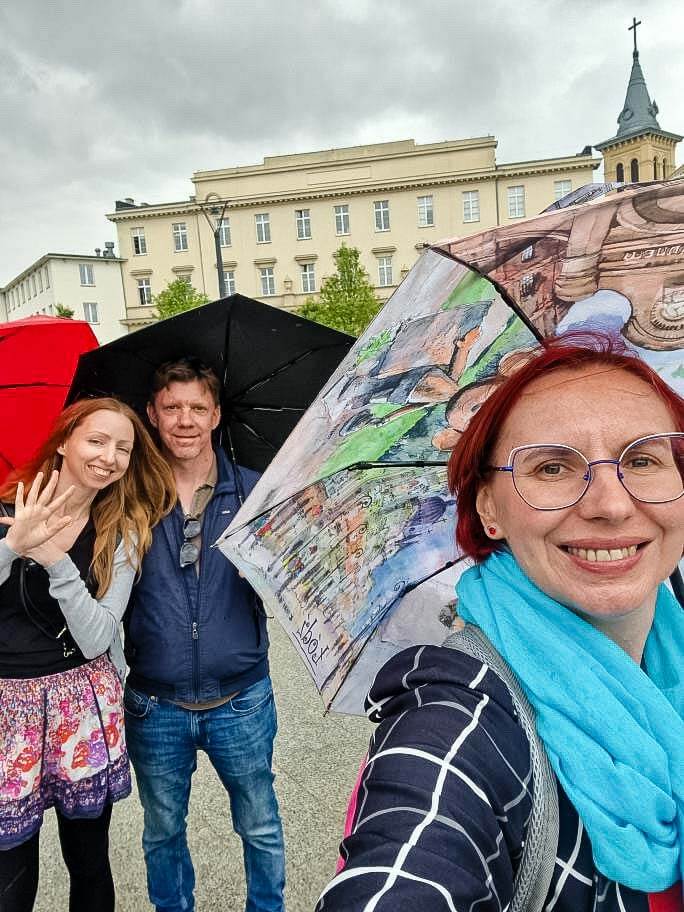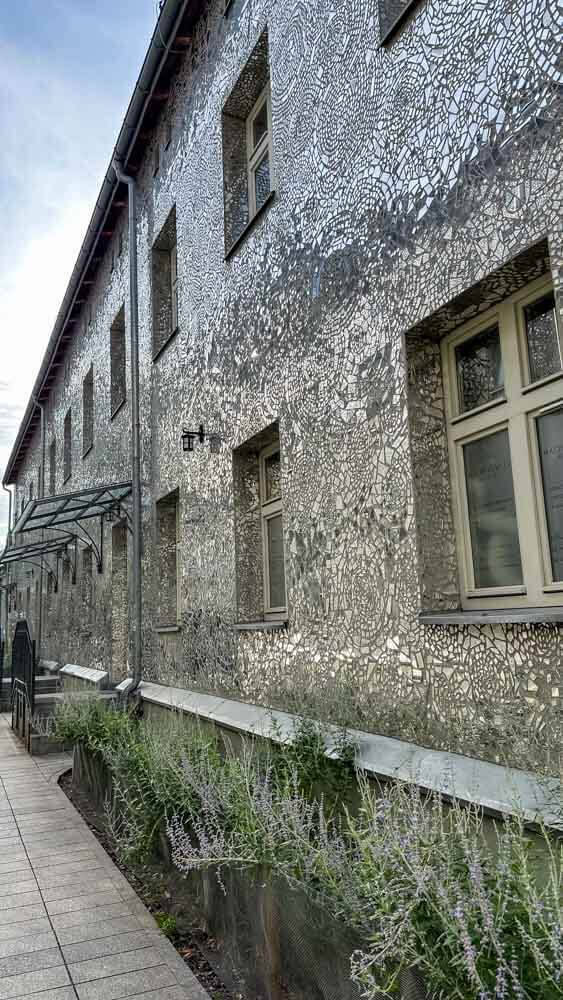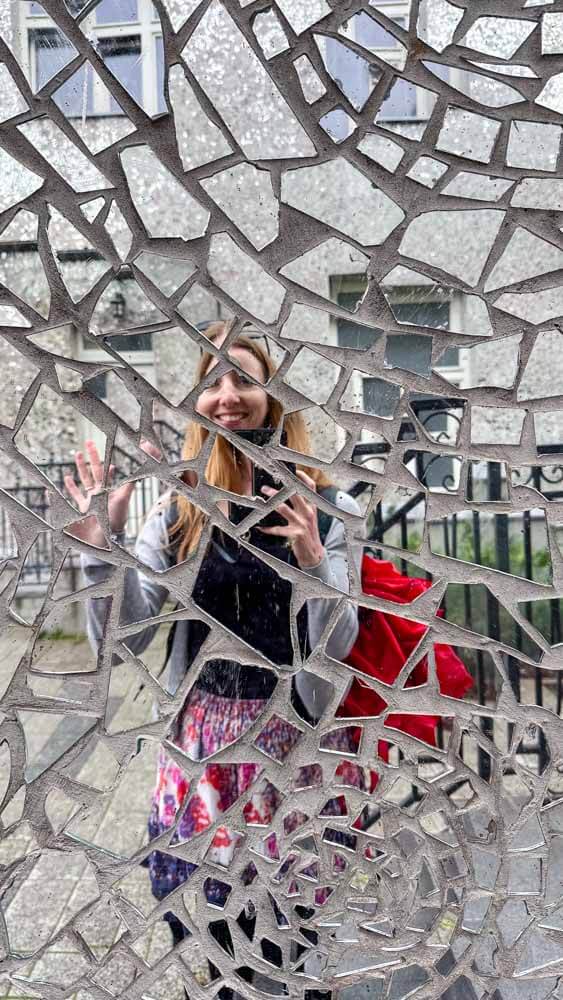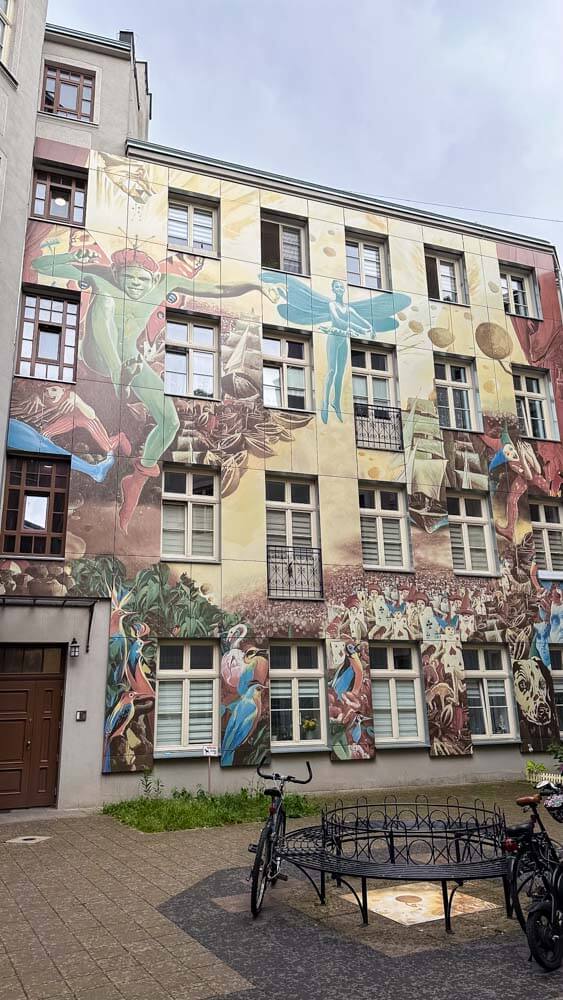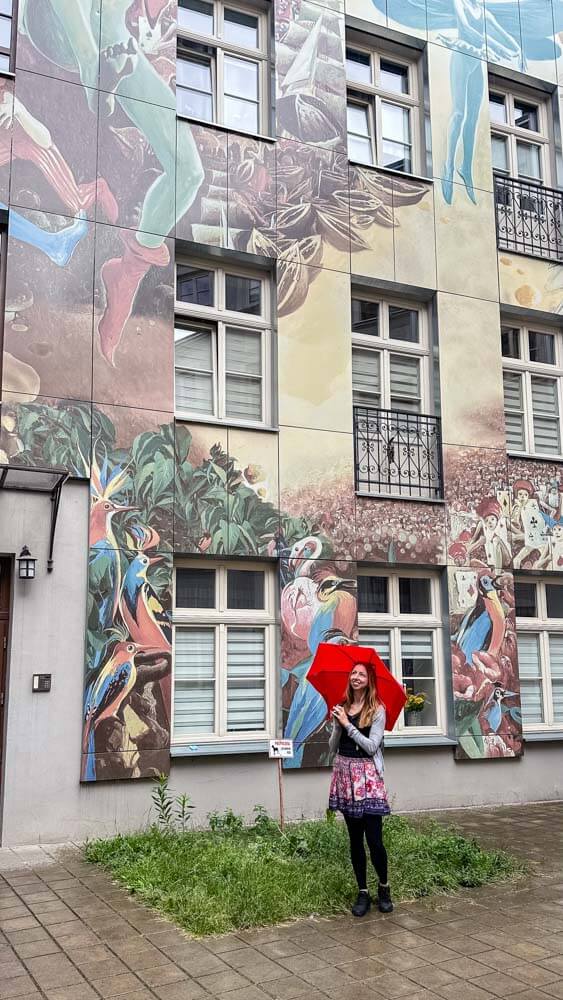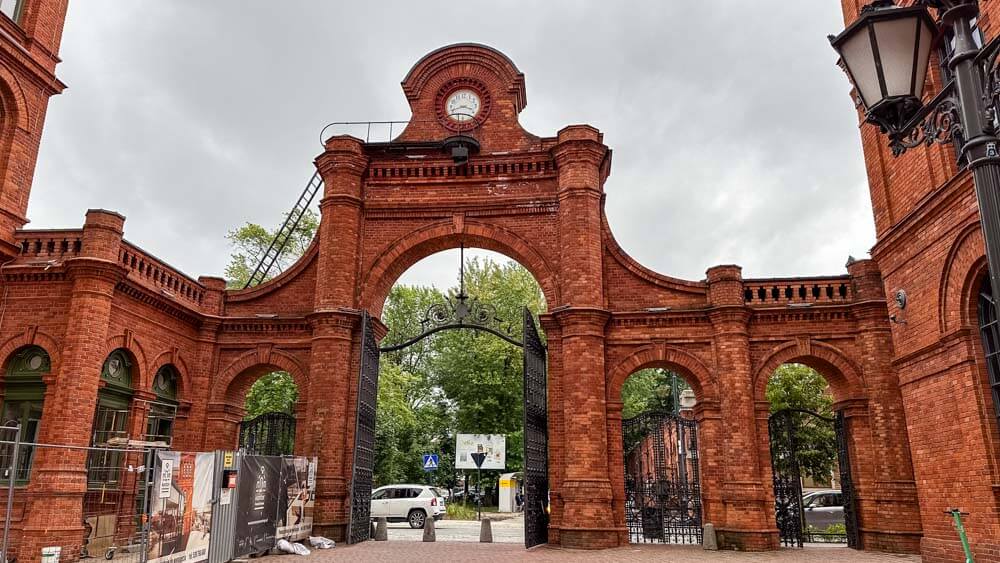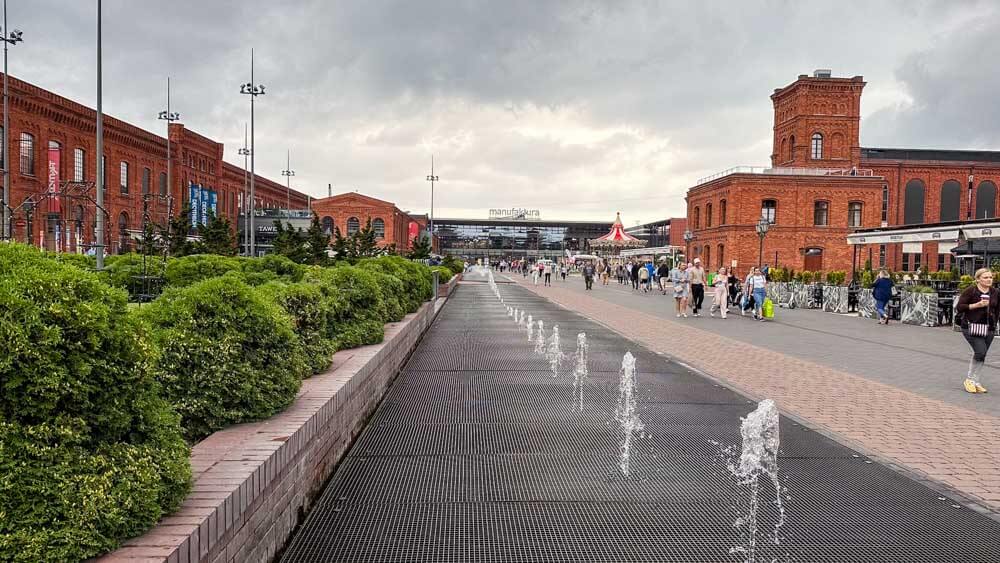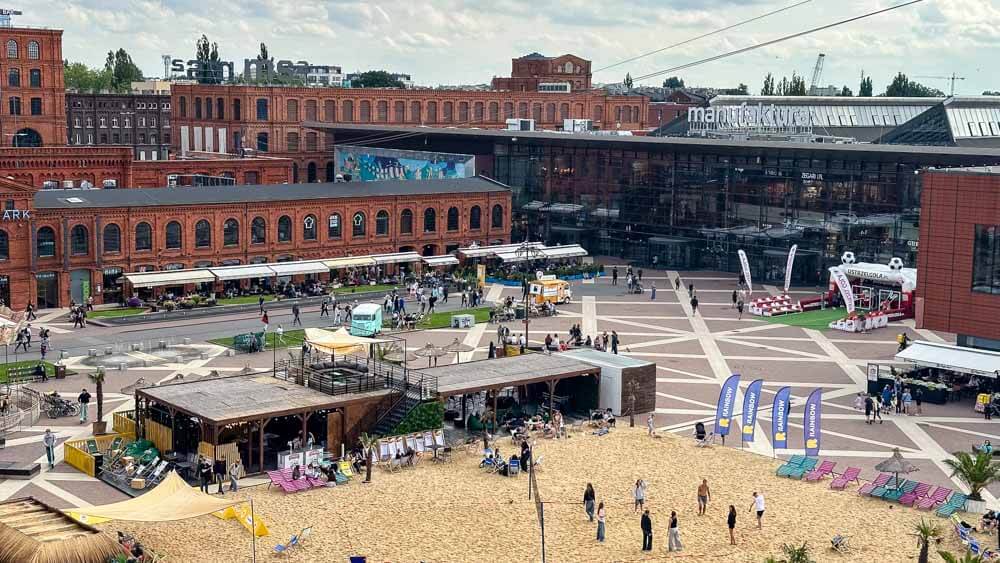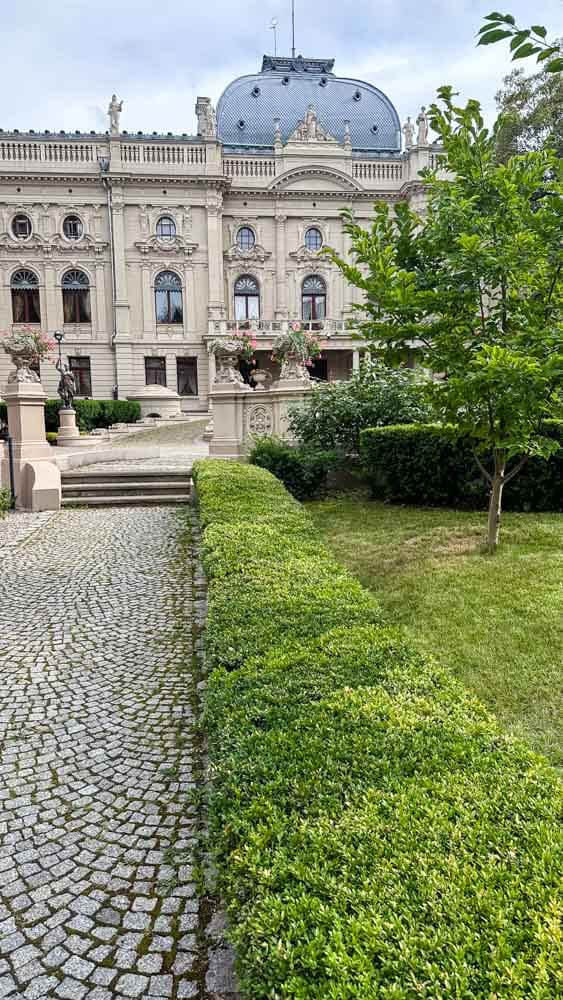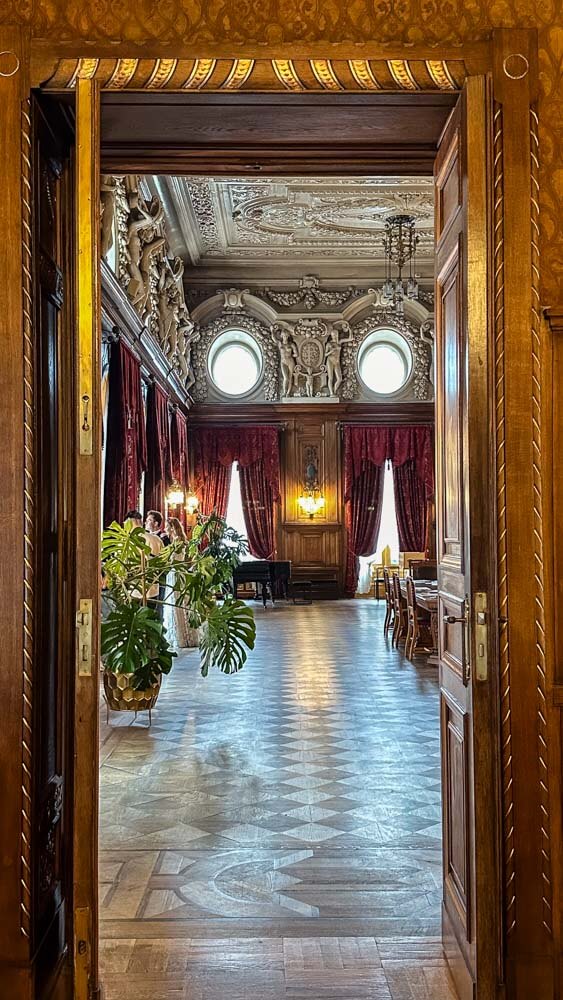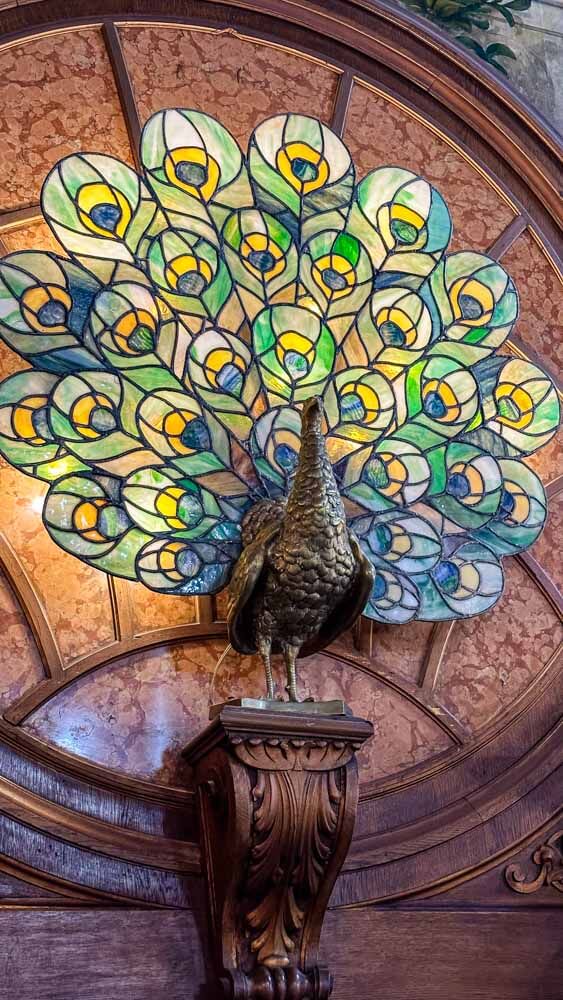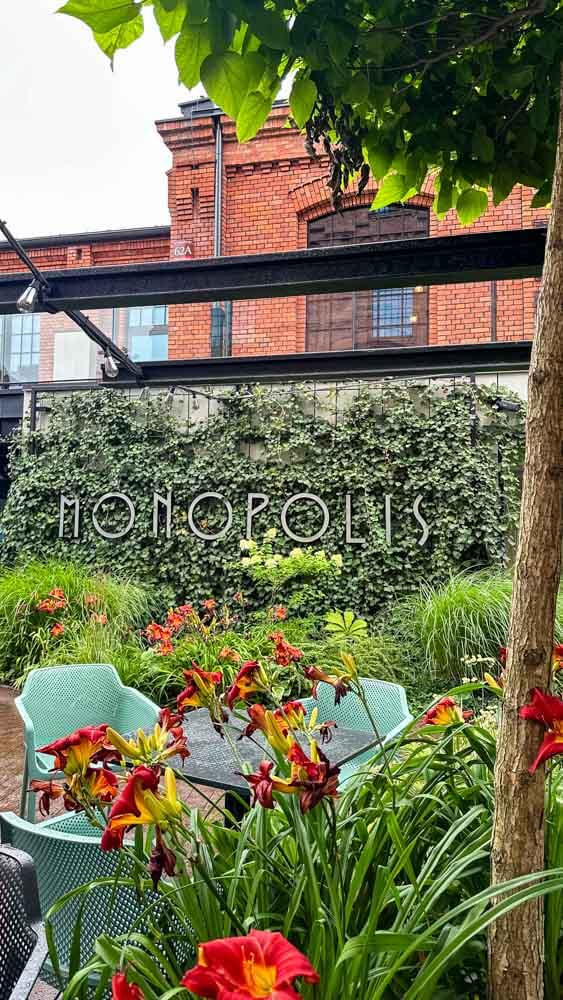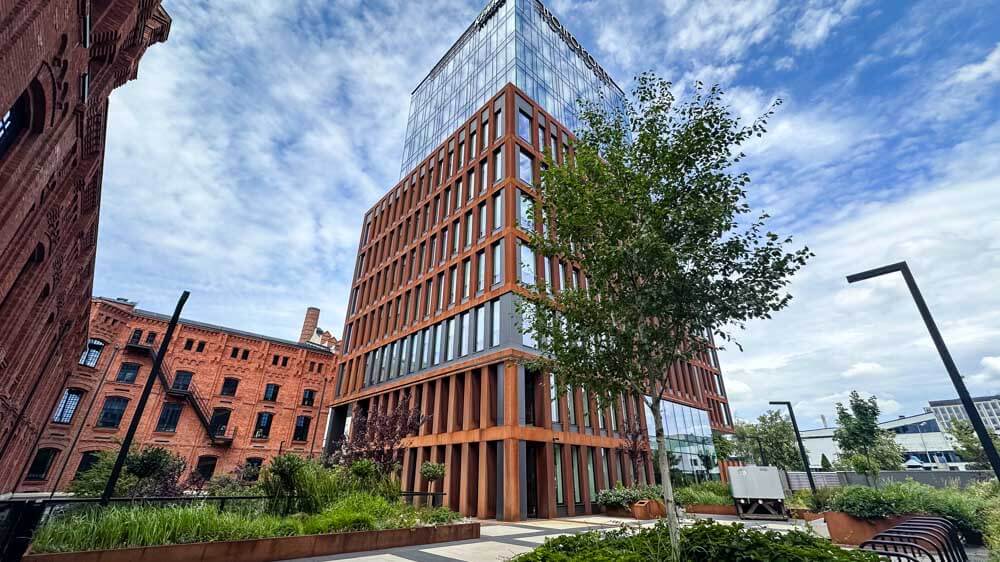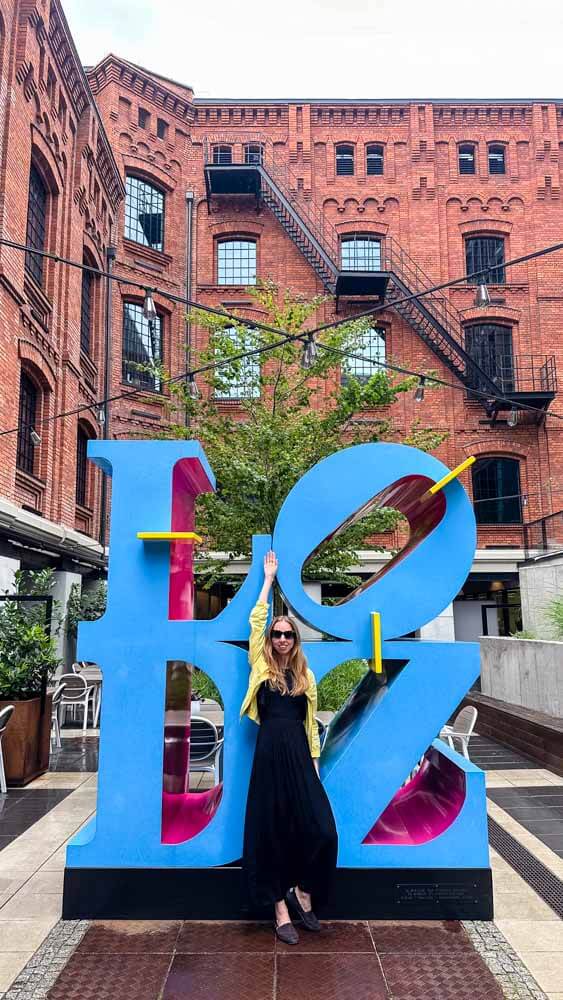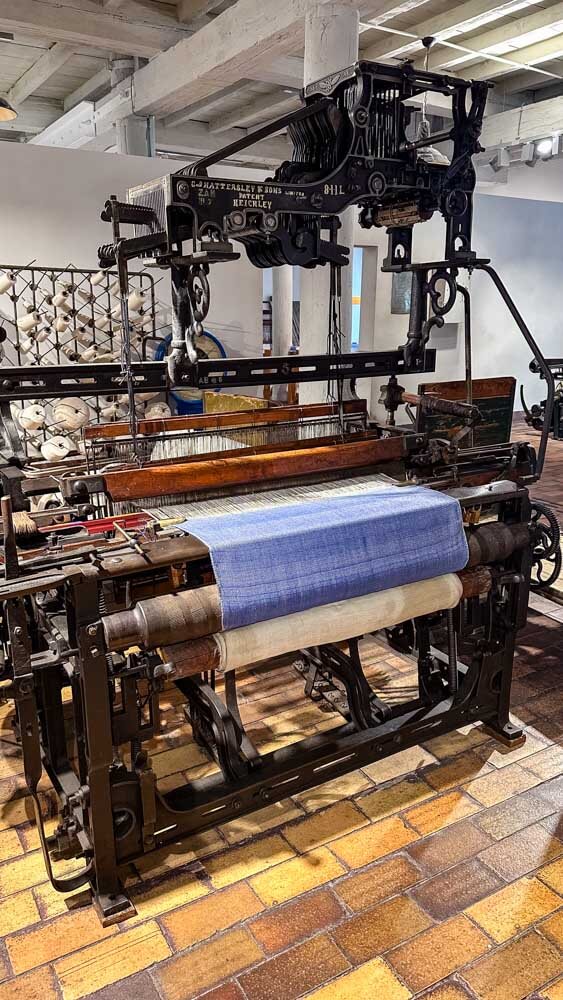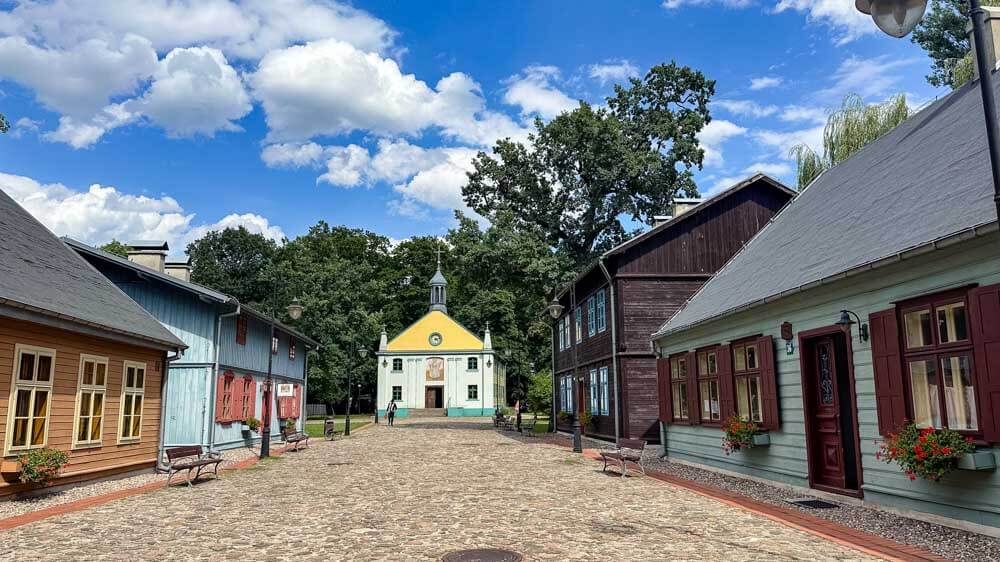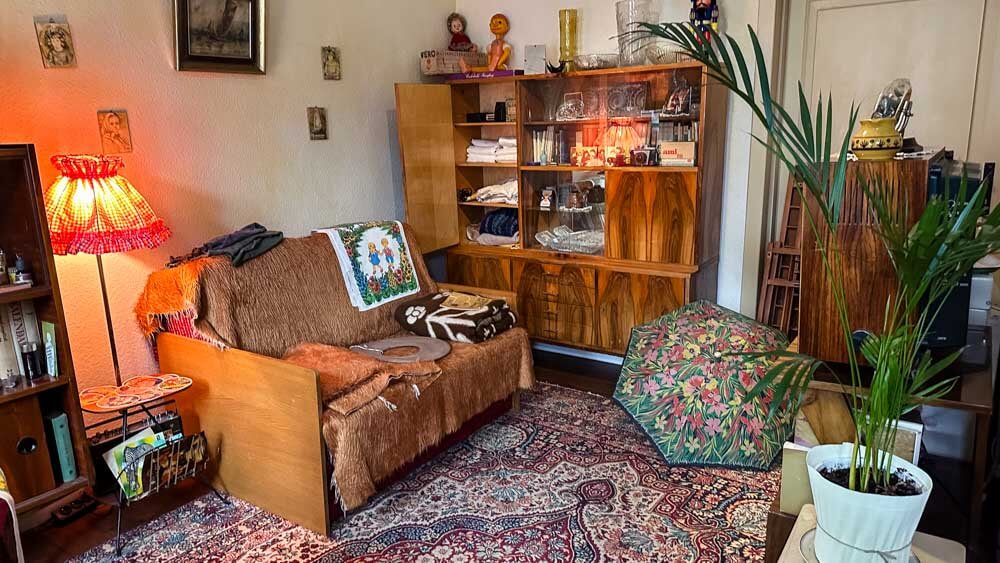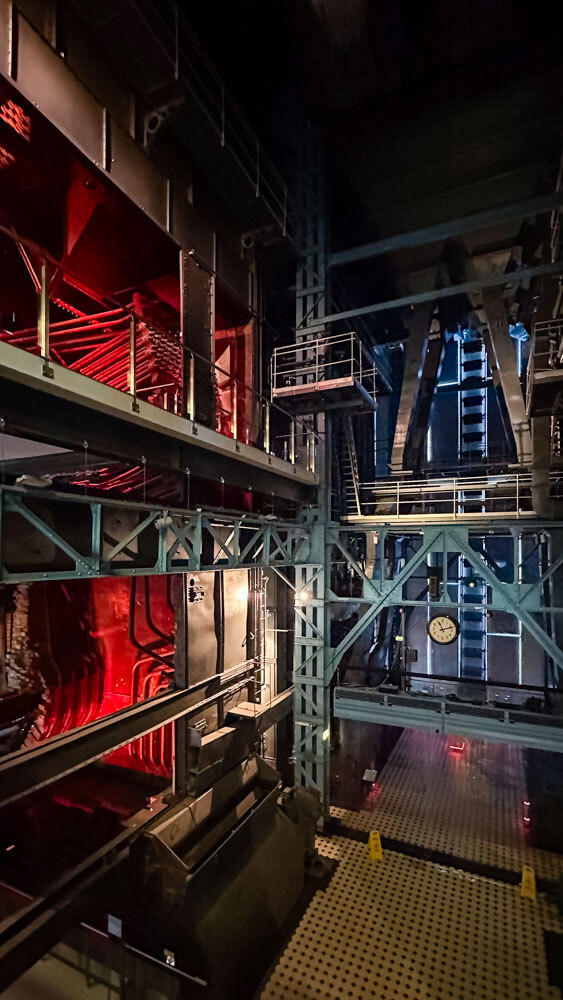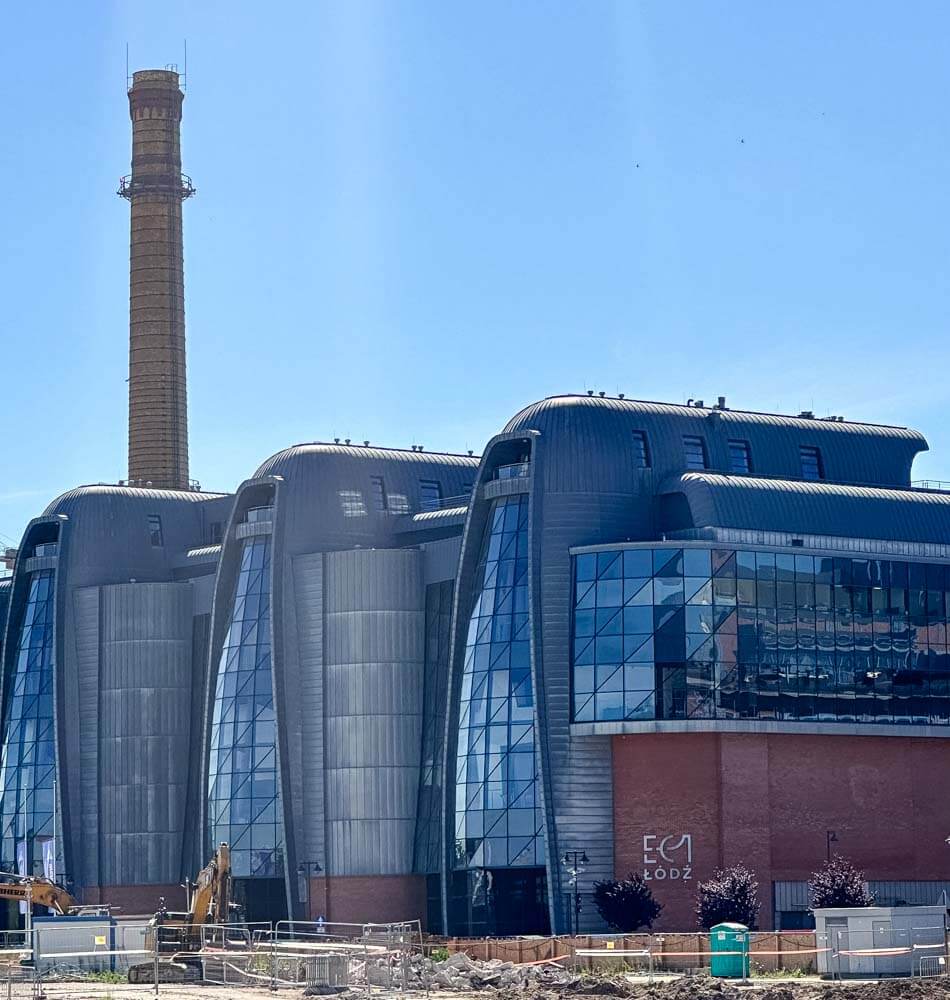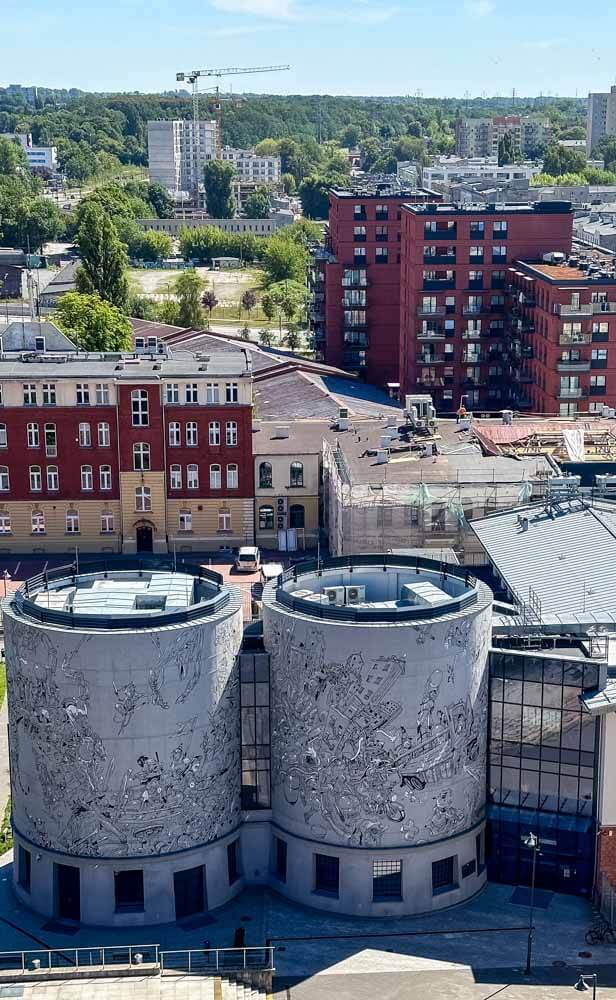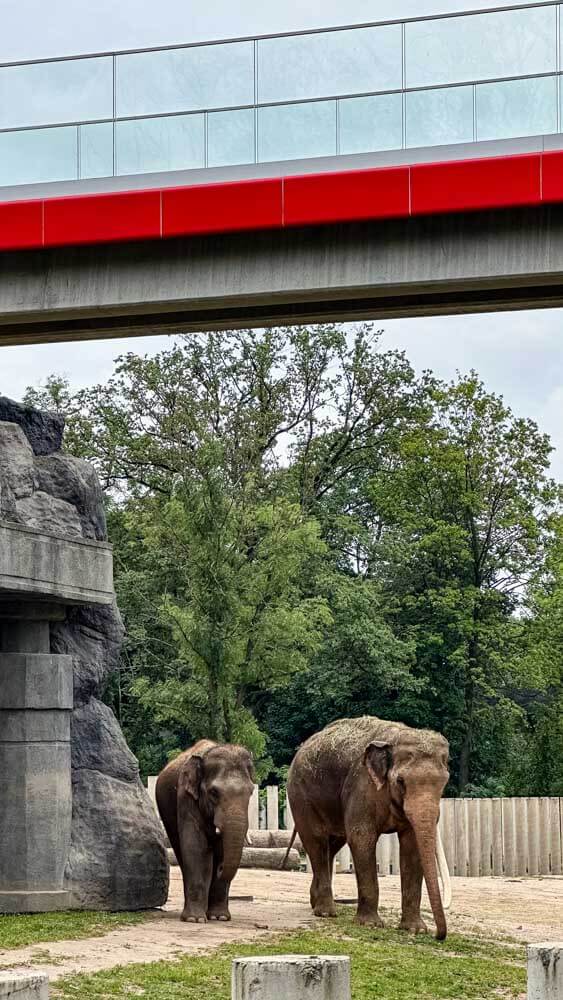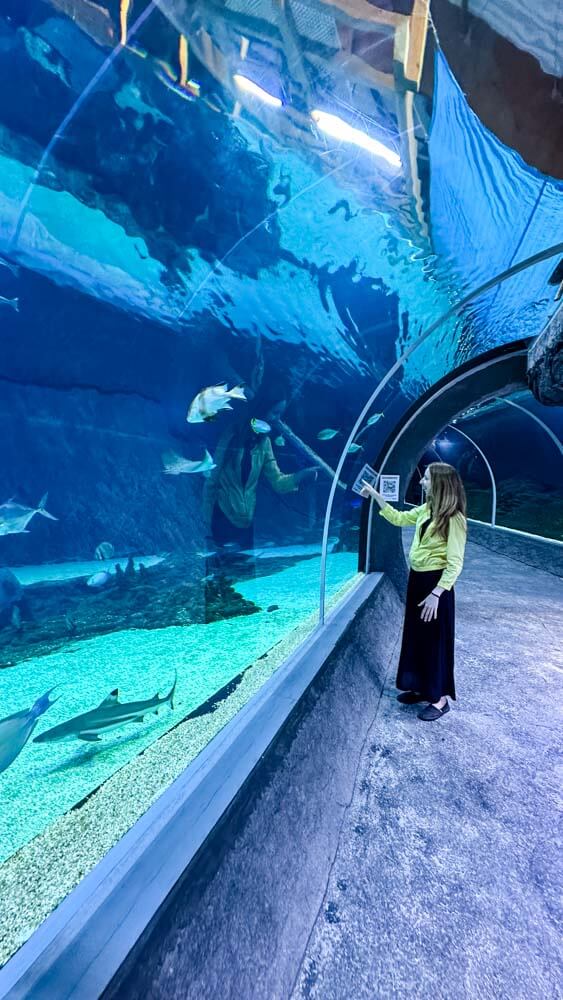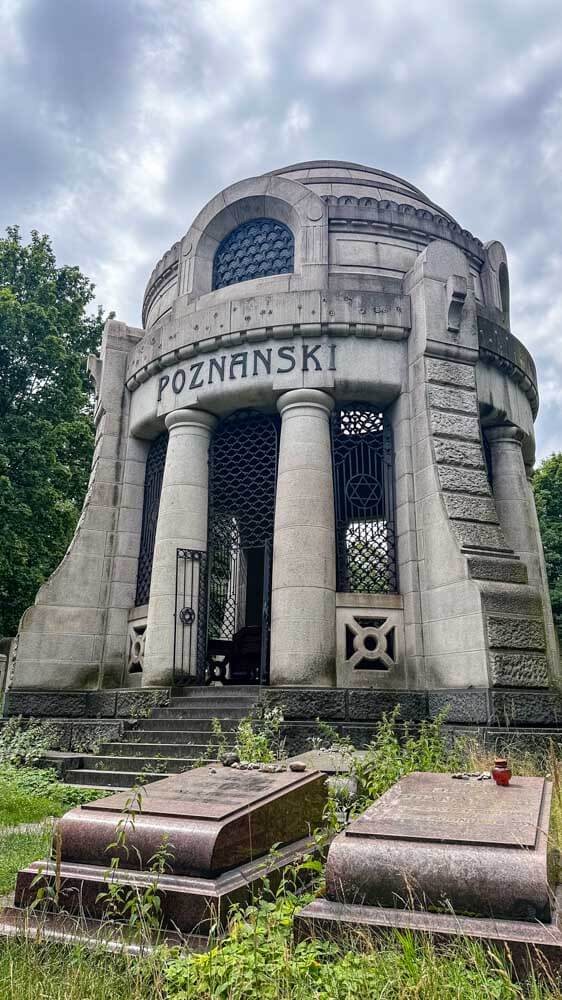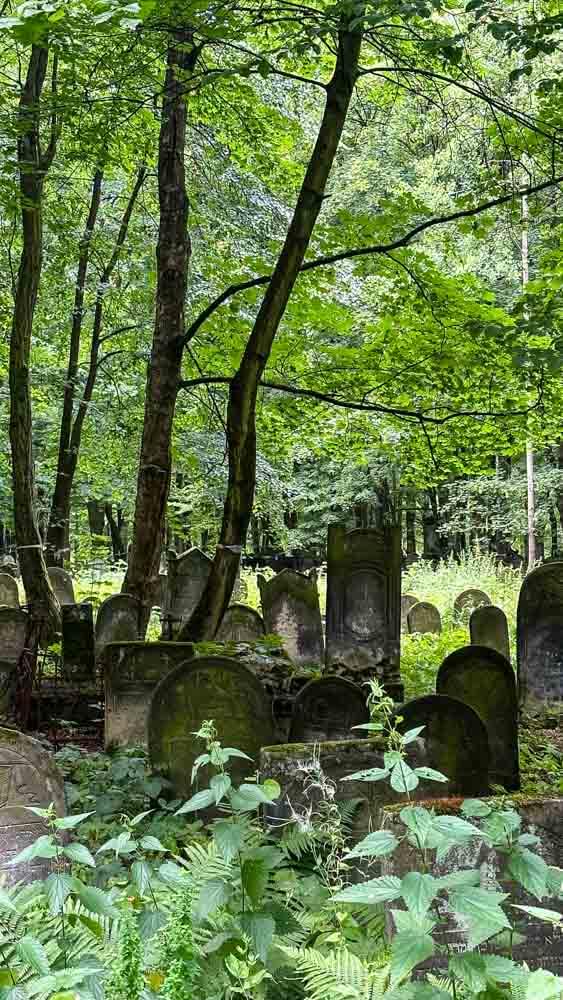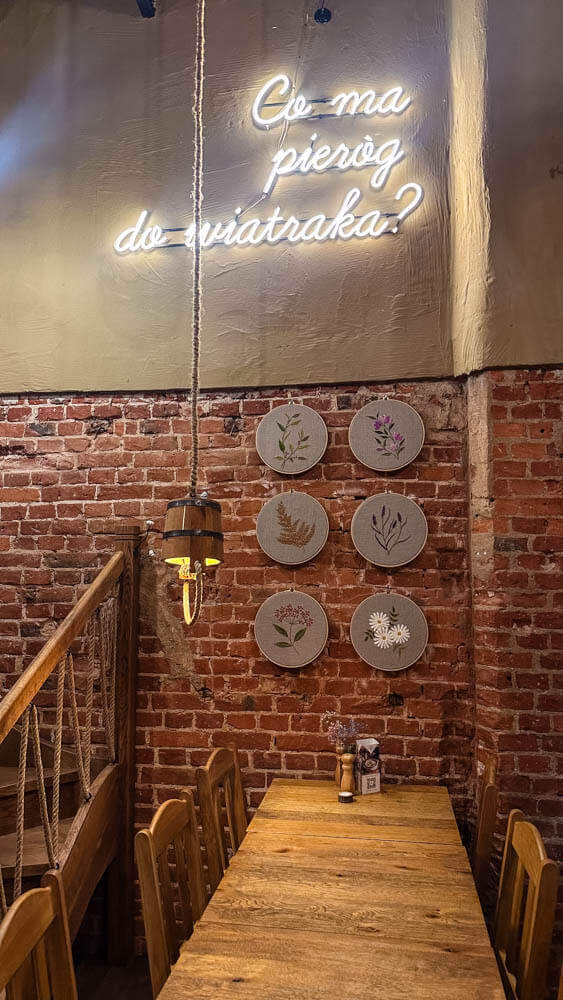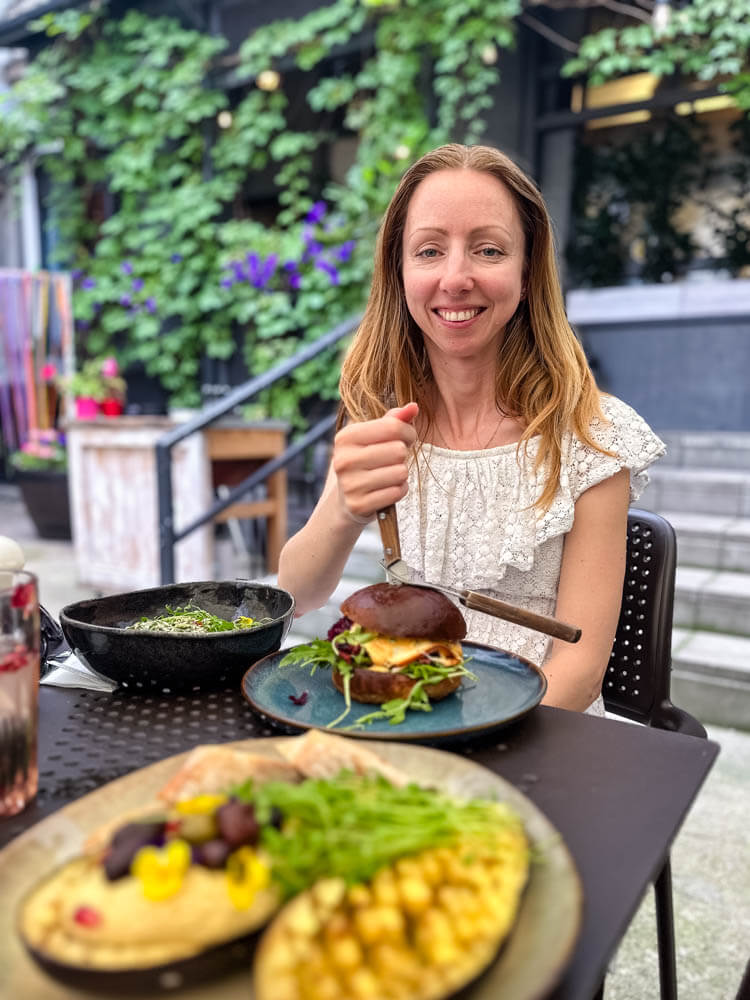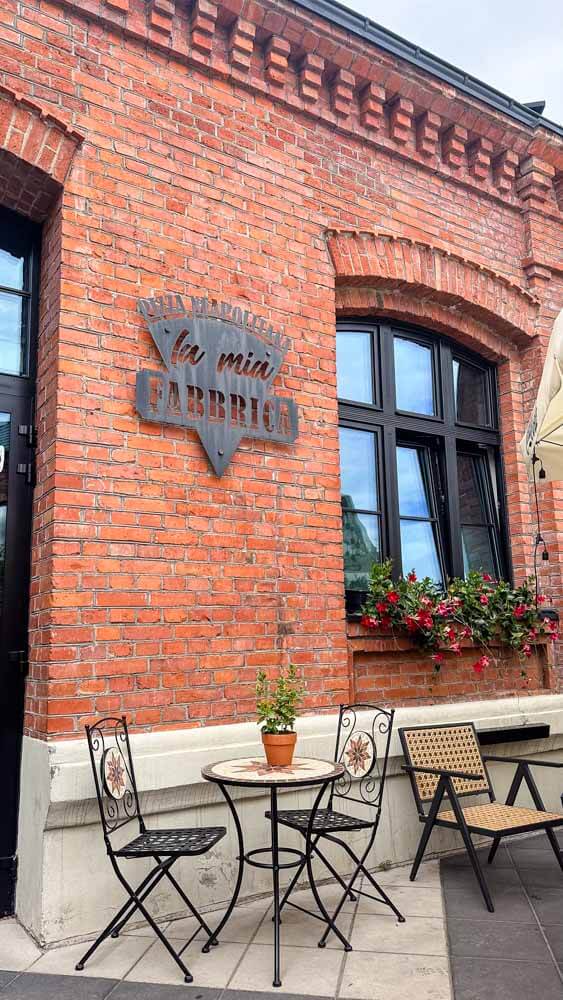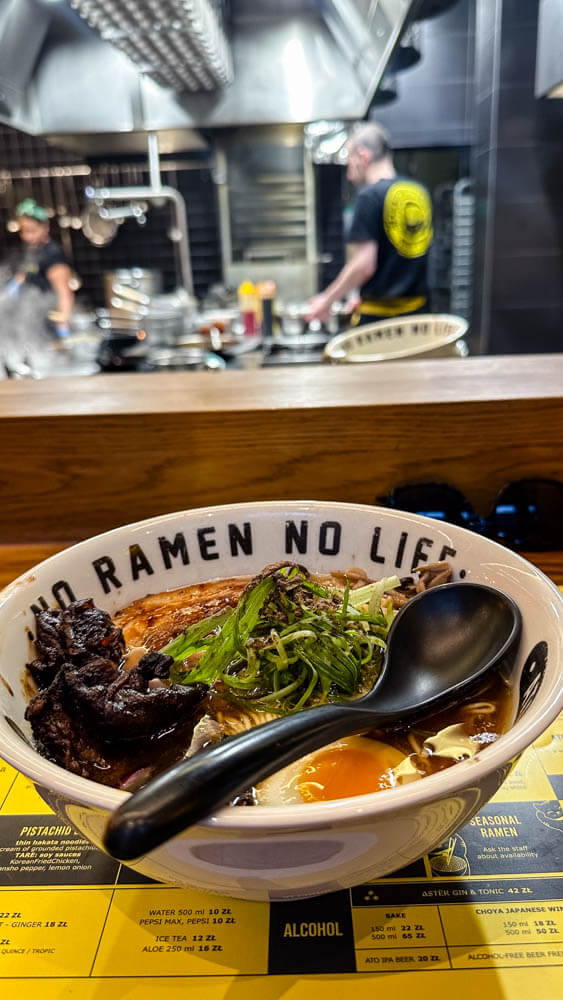Table of Contents
This post is also available in:
![]() Čeština
Čeština
Lodz, or Łódź as it’s written properly in Polish, is a city that hardly anyone has on their bucket list.
It lies off the beaten path, and even Poles often have quite some prejudices about it. I’m glad you landed here as I’m going to reveal the unique charm Lodz carries. And, perhaps like many of my friends and relatives, you too will be surprised and will start considering to visit Łódź, Poland!
Łódź has a rich industrial history which provided a base for today’s unique development. Industrial buildings simply look cool, if you know how to refurbish them. Lodz has become an expert in that, bringing old structures back to life, only this time a lot more vibrant and entertaining.
At the same time, the recent history and culture of Łódź city Poland have been amazingly preserved, making it a veritable time capsule that transports you back into the past to see exactly how it was to live there hundreds of years ago.
This unique combination of historical immersion mixed with a lively and modern present is what makes Łódź such an enjoyable destination.
Oh and something I must mention at the beginning too – the culinary scene is world-class! You can count on being fed well.
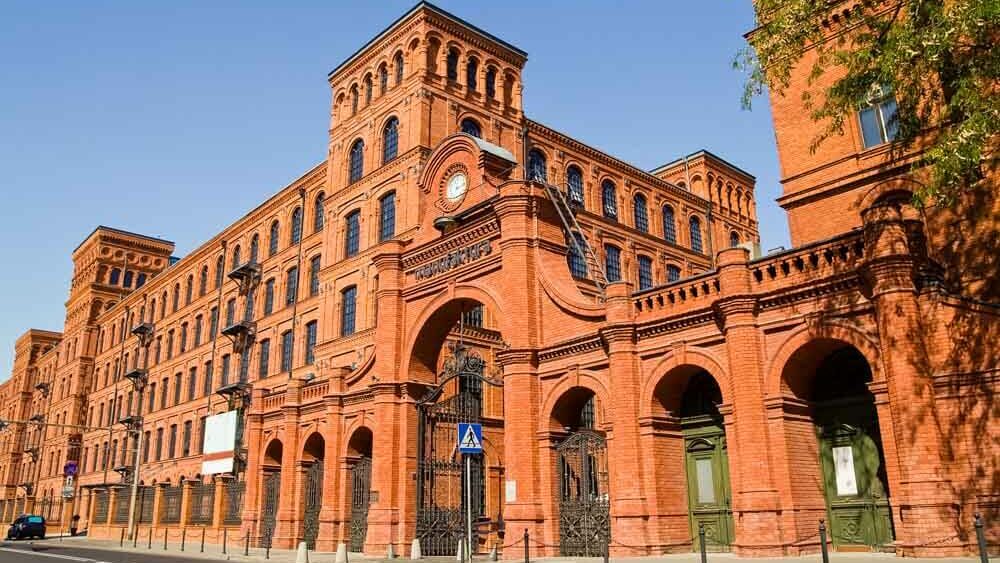
There’s actually much more to do and experience in Łódź than one would think, and that’s why I’m writing this article – to uncover this hidden gem of a city for you.
I was there with my husband for nearly 4 days and went non-stop in order to discover all that Łódź in Poland has to offer.
Of course, you don’t have to be as ambitious as we were to enjoy the city, but it definitely has enough experiences to satisfy even the most curious and robust traveler.
And now, some housekeeping – a.k.a. what’s good to know before you read on:
Lodz Pronunciation
A super easy way to remember the Łódź, Poland pronunciation is to think of the phrase “would you” and drop the word “you” so that you end up with something that sounds like – woodge. That’s how it’s pronounced, really! Kudos to our guide Justyna for explaining it this well.
Why “Łódź”?
The word Łódź means “boat”. However, the reason for the city’s name is a complete mystery, even to locals, as it has no history of harbors, ports or boats. There are several theories but we won’t get into those here. If you see little illustrations of boats everywhere you look in Łódź, you’ll now at least know why.
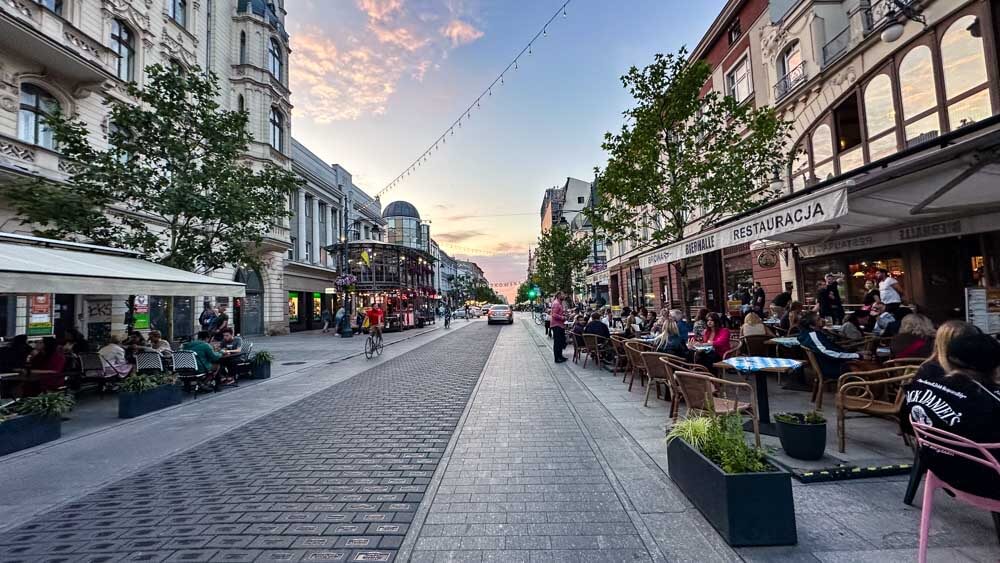
Brief History
Lodz became a city with city rights already in 1434. However, we’re going to zoom in on the modern industrial history of Łódź Poland, which laid the base to its present look and feel.
The colossal industrial boom occurred between 1870 and 1890. It was a period of intense growth for the textile manufacturing industry, leading to a demographic surge that transformed Łódź into one of the largest cities in Poland.
The most noteworthy industrial titans that drove this boom were Karol Scheibler and Izrael Poznański. They were extremely rich and powerful men, for whom to work was definitely not a walk in the park – the oppressive conditions are well known today. Still, they were also responsible for the construction of a number of schools, orphanages, places of worship, and hospitals.
The Second World War wasn’t kind to Lodz and its Jewish population. In Lodz, you could find the second largest ghetto in Poland.
The textile industry fuelled the city for nearly a hundred years. At one point there were around a 1,000 factories!
I found it amazing how big the textile industry became in Lodz, given that cotton had to be transported from afar.
With the collapse of the textile industry in this corner of the world in 1989, the city ended up in a shambles and it’s the time period that gave it its bad rep, especially among Poles.
However, Lodz managed to magically reinvent itself. Now, 30 years later, it’s a buzzing, lively city full of patriotic locals. Seriously, everyone I met was so proud of their town. It was heartwarming!
What to Do in Lodz Poland
If you’re reading carefully from the start, you might be wondering what’s the whole deal with the textile manufacturing, which naturally doesn’t typically arouse a great amount of passion and curiosity.
Thus, I’d like to impart to you that textile manufacturing is not actually the point. Rather, the main point of the Łódź attractions listed below is the historical significance of the unique industry, how it operated and how it came to shape this part of Poland.
It’s also about discovering how people lived and worked during this time. The sprawling factory complexes, and opulent palaces created during this era have been immaculately preserved and repurposed to provide you with an intimate introspection into this illustrious bygone era.
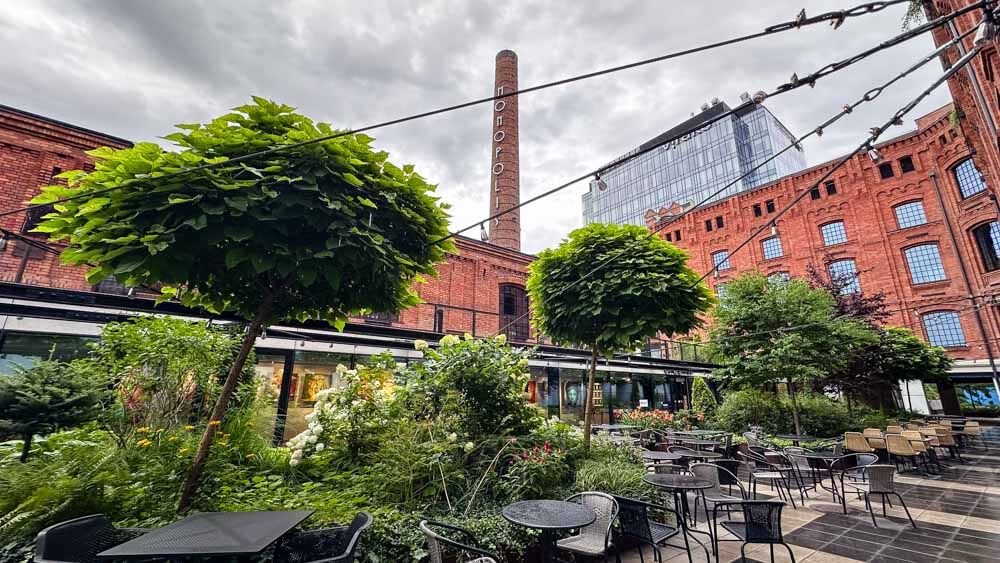
So without further ado, let’s cover what to do in Łódź and some of the historical treasures that you’ll find on your visit.
Many of Lodz sights are free to visit. If there’s an entrance fee, I’ll mention it.
Piotrkowska
Piotrkowska is the main boulevard and center of activity in Łódź, and one of the country’s most iconic and vibrant thoroughfares.
Since Lodz doesn’t have a city center in the traditional sense, the long Piotrkowska Street (a whopping 2.6 miles or 4.2 km!) serves as a great alternative. I loved wandering along the boulevard day and night, also thanks to our conveniently located hotel Pietryna.
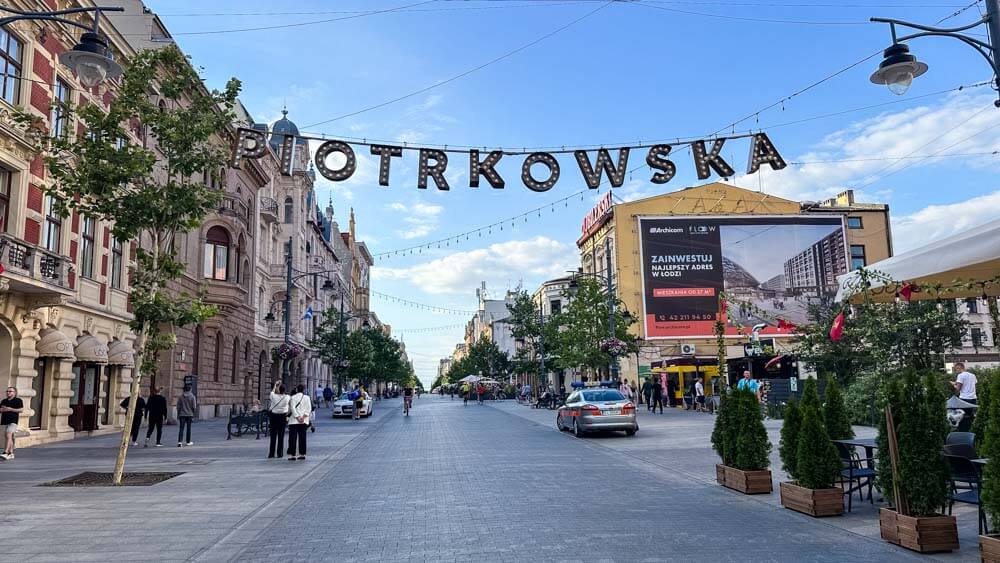
I can attest that Piotrkowska offers an energetic city atmosphere with all of the restaurants, cafes and shopping that one could ask for.
The summer evenings that we enjoyed there were teeming with garden restaurants and bars, full of locals and travelers alike enjoying themselves and making the city a lively adventure for all.
One of the best things to do at Piotrkowska, other than eat and drink, is to simply people-watch. The diversity of people’s styles and outfits is astounding and definitely gives out a Berlin-like vibe.
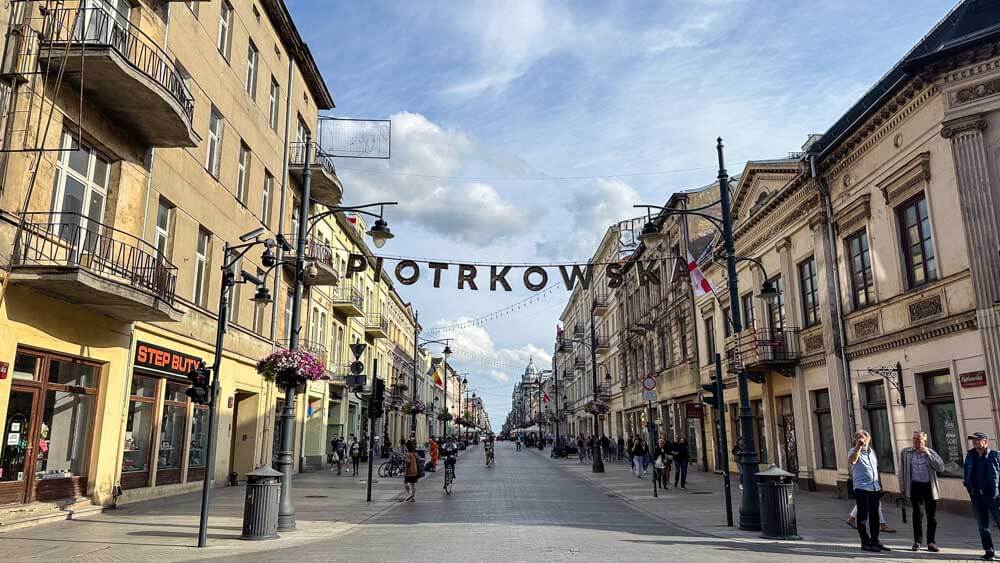
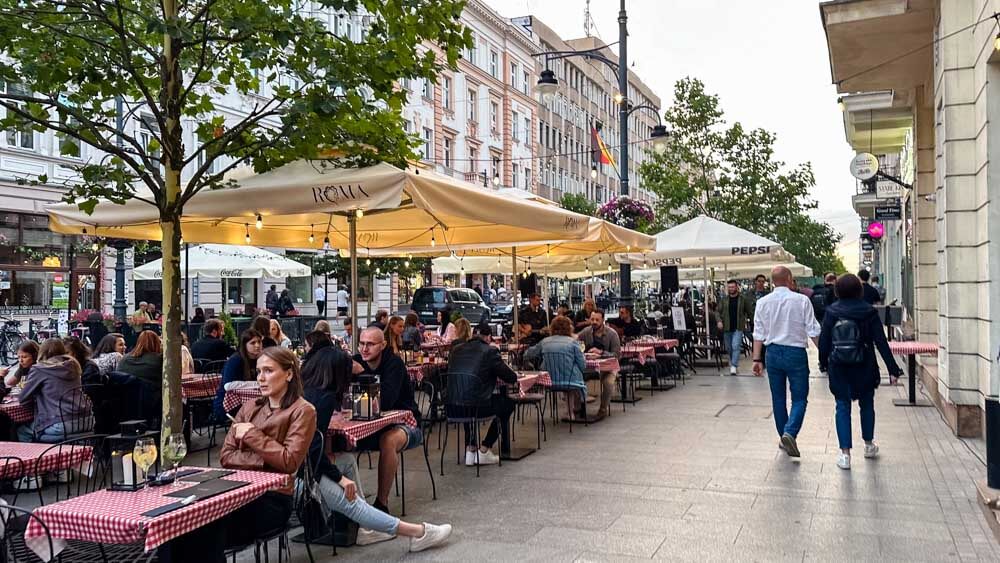
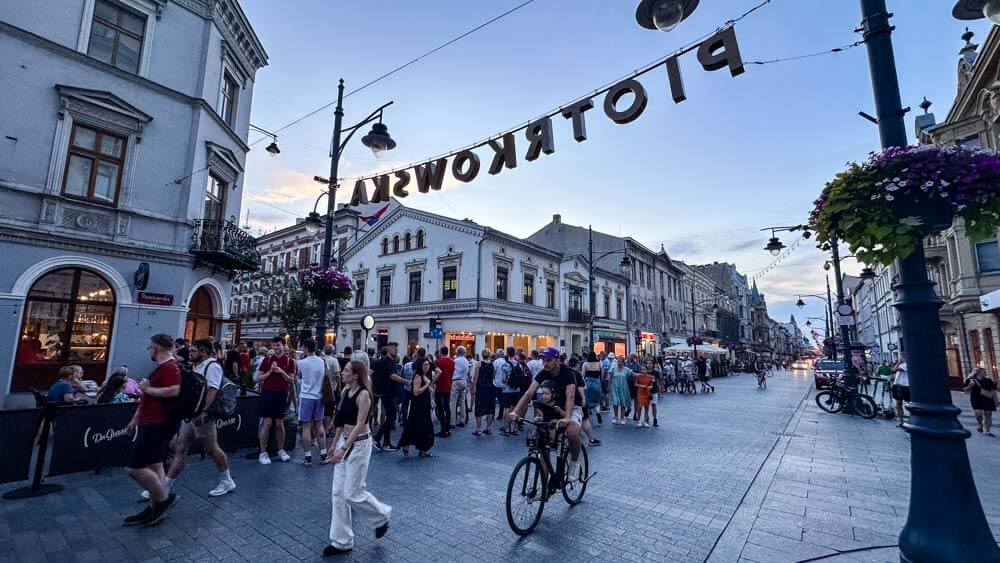
Also, when wandering along Piotrkowska, sneak a peek into any courtyard that’s open.
Why?
You might come across some real gems:
Rose Passage at Piotrkowska 3
This captivating installation has become a significant cultural landmark. The mirrors, which cover several buildings from top to bottom, are meticulously arranged in the shape of roses, and offer a unique interplay of light and reflection, transforming an ordinary city space into visual poetry.
On a sunny day the mirrors come alive, offering a different visual experience with every glance. It’s a beautiful place to visit with a deeper meaning. The artist’s daughter Rose suffered from an eye melanoma and had her retina damaged. This artwork symbolizes her path of recovery and at the same time reminds us of what a miracle eyesight is.
Birth of the Day at Wieckowskiego 4
Okay, you have to make a turn from Piotrkowska to see this courtyard but the large murals from the fantasy world are so worth it! They are printed on large ceramic tiles and symbolize the opposing worlds of the good and evil.
One last street art project on Piotrkowska that I’m going to mention here is:
Unicorn Stable & Statue
The pedestrian part of Piotrkowska Street ends with Mickiewicza street, and it’s right there where you can find this wonderful creation from the world of unicorns. A large tram intersection received a tall, pastel-colored roof that locals aptly nicknamed the Unicorn Stable.
The city ran with the joke and additionally had a unicorn statue built there. It’s just one of many examples of how the city listens and adapts to its population, and often in a playful way!
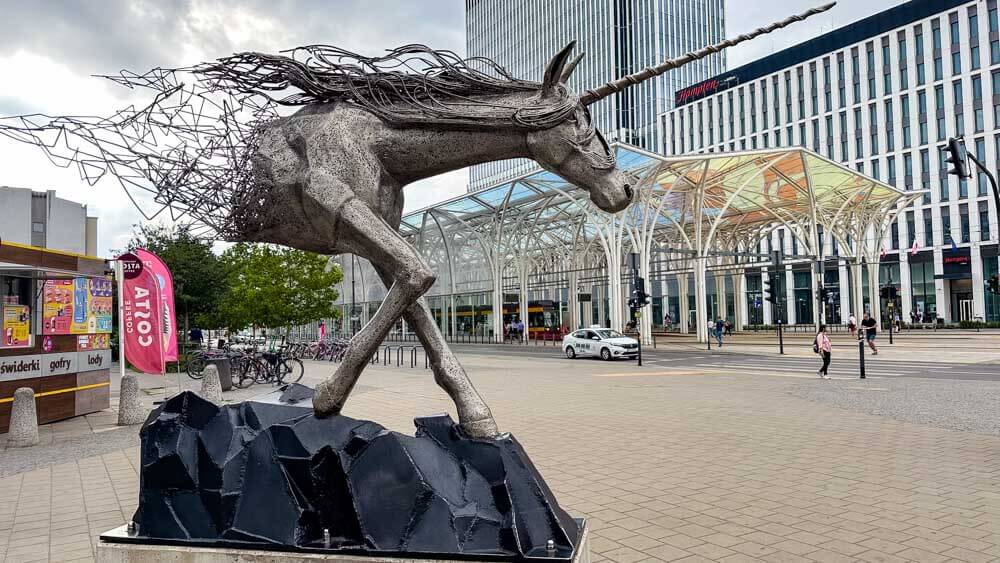
In fact, Lodz is dotted with large murals and amazing street art. If you’re interested in exploring it more, you can find a handy guide on Lodz’ tourism website or grab a free map at the tourist info center at Piotrkowska 28.
When it comes to places to visit along Piotrkowska, one large structure stands out:
OFF Piotrkowska
Piotrkowska 138/140
OFF Piotrkowska is a bustling cultural enclave that attracts locals and tourists alike. What used to be a cotton mill has become a labyrinth of repurposed industrial buildings transformed into a totally hip scene filled with food trucks, bars, restaurants, artist studios, shops, and clubs.
At the time of our visit the Euro championship was on and so we experienced first-hand the energizing vibe of football fans cheering for their teams in front of a large screen outside.
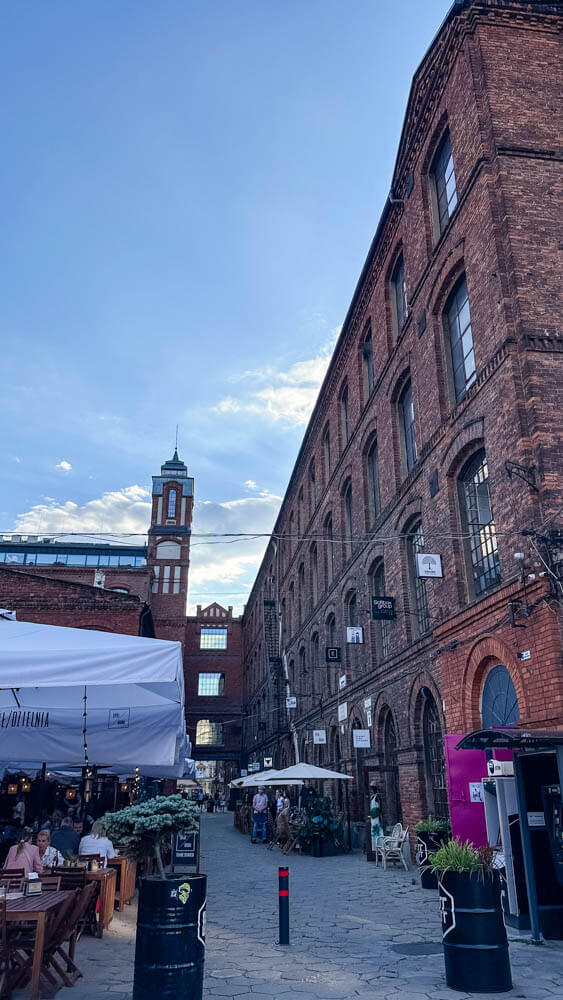
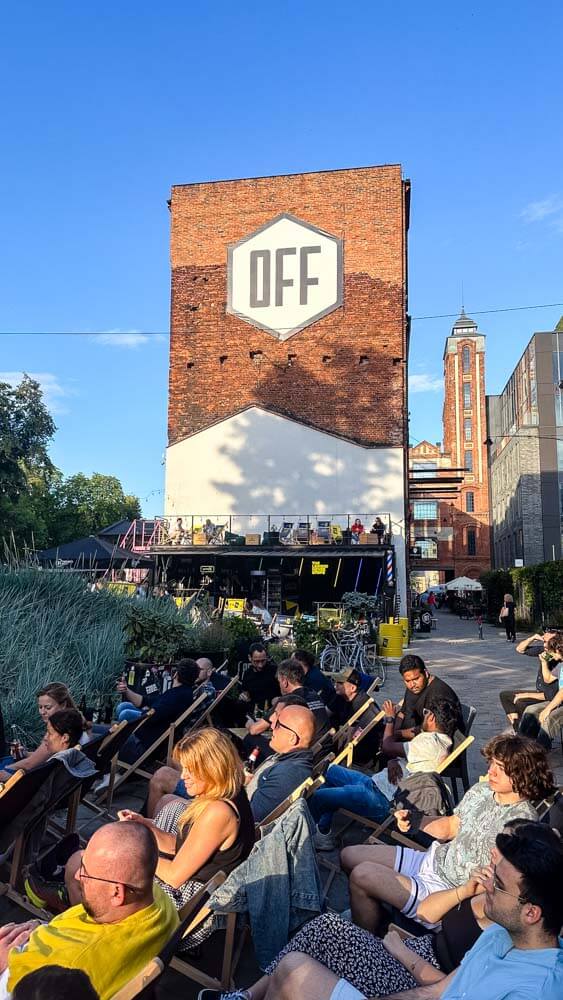
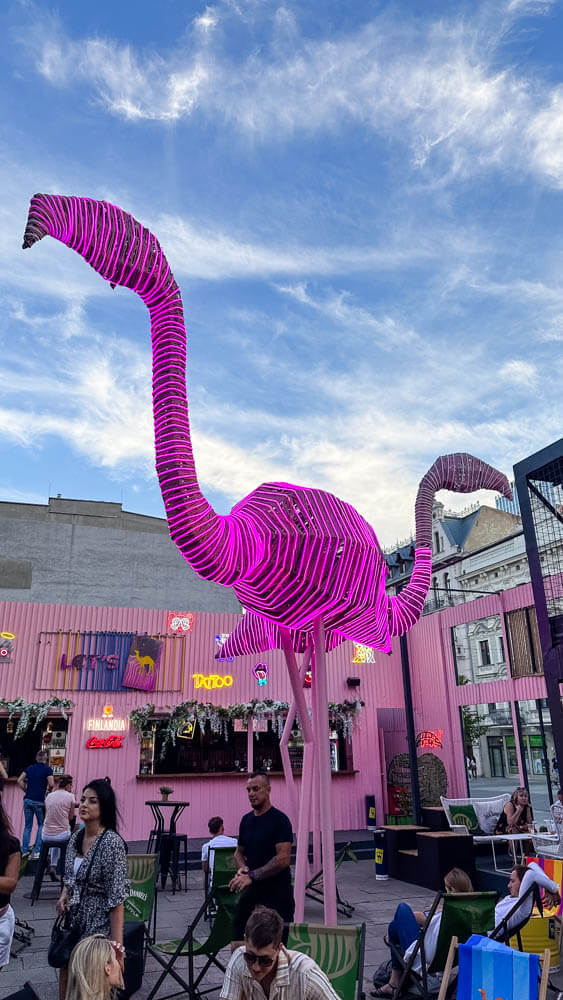
We simply enjoyed strolling through OFF a few times and didn’t choose to stay for a meal but even like that, OFF Piotrkowska is a must if you want the full Łódź experience.
Liberty Square (Plac Wolności)
To its northern end, Piotrkowska finishes with a medium-sized square. Again, this is not the heart of the city center, rather only a part of the prolonged “heart” that Piotrkowska Boulevard acts as.
Still, the Liberty Square is a pleasant place to stroll around, to sit on a bench and admire its fountain in the middle as well as a monument to Tadeusz Kościuszko, a Polish national hero.
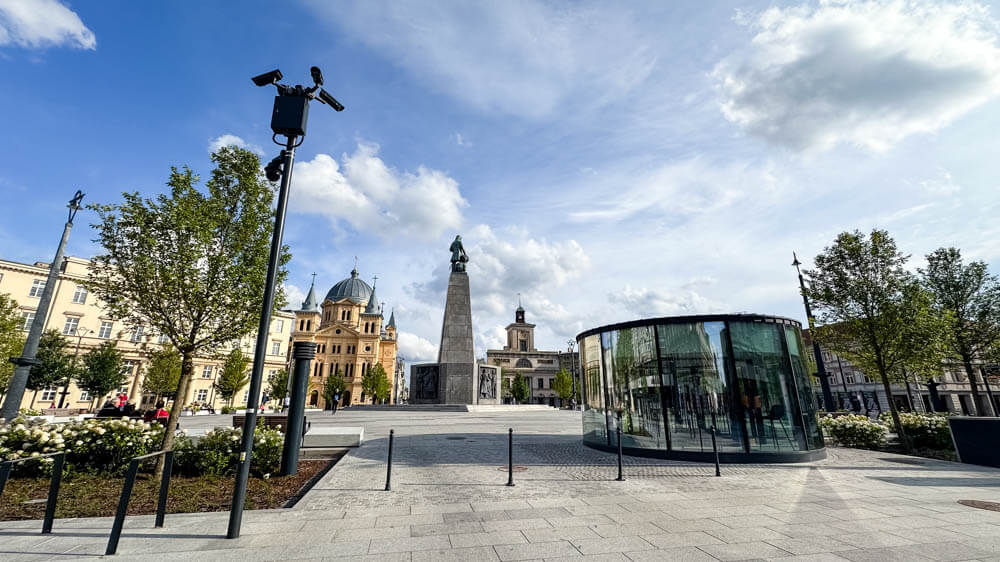
Lastly – if you want to experience Piotrkowska Street in an unusual way, you can hop on a rickshaw! Yes, you read that right. :) They’ve been roaming Piotrkowska’s pedestrian area up and down since 1998, yearround! A single ride costs PLN 5 per person.
Manufaktura
Drewnowska 58
Manufaktura is a massive textile manufacturing complex formerly owned by Izrael Poznański. During its industrial heyday, Manufaktura Łódź Poland was a self-sufficient community that included everything necessary to house its workers and provide them with all of the necessary living amenities.
In the early 2000s, the former Manufaktura complex underwent a major restoration project, with the goal to repurpose the space for modern uses while preserving the historical integrity of the traditional brick architecture.
The result includes over 300 shops and boutiques, along with numerous restaurants, cafes, and bars that offer a wide variety of cuisines.
The complex also includes a cinema, a bowling alley, a fitness center, and an adventure park with a professional boulder wall! It features a large plaza that hosts concerts, festivals, and other public events.
During the winter there’s an ice skating rink, and in the summer you can chill at a sand-filled beach area complete with volleyball court and a convenient beach bar pop-up. It rained during our summer visit so we only enjoyed looking at it all.
If you want to dive into the history of Manufaktura, you can visit the Museum of the Factory and learn about Poznanski and the business he ran there. The employees will also turn on the textile weaving machine and explain the process of transforming yarn into fabric. It’s a nice little museum to visit and it costs only PLN 14 for an adult. You can find further ticket information on the museum’s website (in Polish).
And if that wasn’t enough, you’ll also find a zip line so that you can ‘fly’ above the complex from one side to the other.
The renovation and repurposing of the Manufaktura complex has transformed it into something truly amazing, making it an absolute must-see for all visitors of Łódź.
Museum of the City of Lodz – the Palace of Izrael Poznański
Ogrodowa 15
Izrael Poznański’s palace is conveniently located nearby his former factory complex, so a tour of this opulent palace is a perfect complement to your Manufaktura visit.
As one of the most affluent textile manufacturers in Łódź, Poznański’s palace clearly reflects his substantial social status. It not only served as his private residence but also as a symbol of the wealth and influence wielded by the textile barons of the time.
The exterior of Poznański’s Palace is a visual feast of architectural styles, prominently featuring Neo-Renaissance, Neo-Baroque, and Neo-Rococo elements.
Inside, the palace is equally breathtaking. Lavish decorations, including stuccoes, frescoes, ornate woodwork, and stained glass, create an atmosphere of luxury and refinement. Each room in the palace tells a story of elegance, with meticulously designed interiors that showcase the finest craftsmanship of the period.
We saw couples taking wedding photos inside, and I bet the garden with the palace’s exterior serve as yet another beautiful backdrop for romantic photos.
Poznański’s Palace is more than just a beautiful building; it’s a symbol of Łódź’s industrial legacy and cultural heritage that stands as a reminder of the city’s golden age. Whether you’re an architecture enthusiast, a history buff, or simply looking to explore the cultural treasures of Łódź, Poznański’s Palace offers a captivating journey through time.
A full-price entrance to Poznanski’s Palace is currently at PLN 22. You can find up-to-date ticket prices on the palace’s website.
Księży Młyn
Księży Młyn, i.e. Priest’s Mill, was developed in the 1850s by Łódź’s most noteworthy industrialist, Karol Scheibler. Under his direction, Księży Młyn became one of the largest and most modern textile manufacturing centers in Europe.
Scheibler’s vision for Księży Młyn was to develop a self-sufficient community. In addition to its factories, the complex also included workers’ housing, schools, a hospital, and even a fire station, all creating a unique microcosm of industrial society, where work and life were intricately intertwined.
Today, Księży Młyn Łódź Poland is a vibrant district that attracts both locals and tourists. It’s a hub for artists, entrepreneurs, and cultural enthusiasts, offering a mix of galleries, cafés, restaurants, as well as event spaces.
Some of the residential blocks still house people. And if you look carefully, you’ll see which movies were shot right here in the maze of red brick buildings.
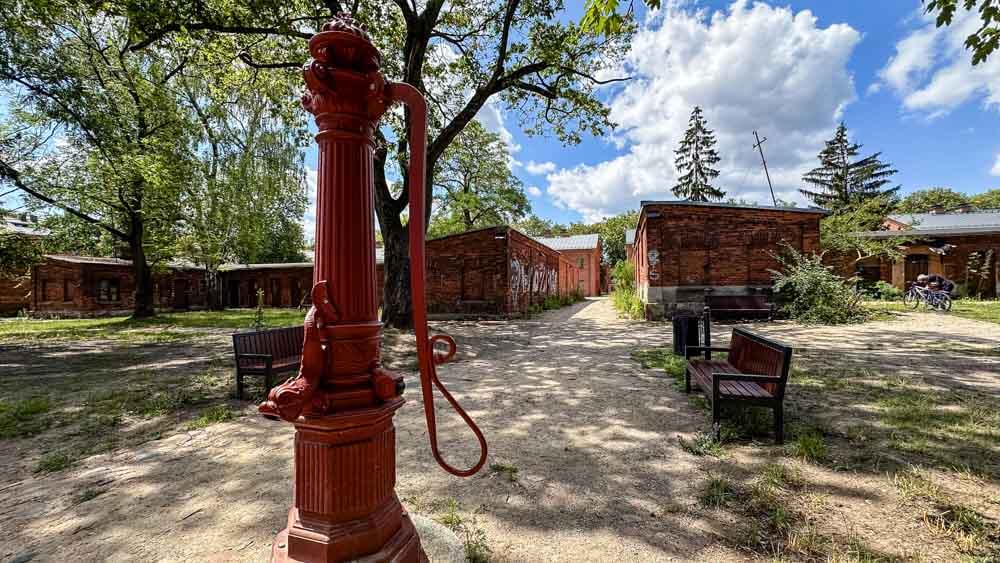
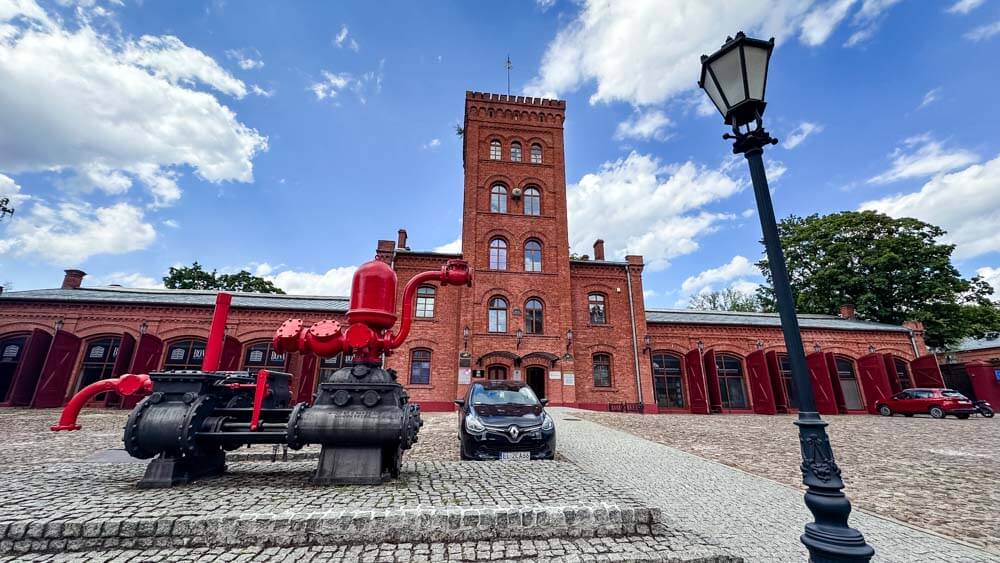
Księży Młyn is a remarkable example of urban regeneration that demonstrates how bygone industrial sites can be repurposed to serve modern needs while preserving their cultural and historical significance.
Come here at least for a stroll through the complex and sit down for a cup of coffee or lunch, like we did, and take in the atmosphere of the place.
Cinema Museum in Lodz (Scheibler’s Palace)
plac Zwycięstwa 1
Another prominent feature of Łódź tourist attractions is its cinematic culture that has significantly shaped both national and international film landscapes.
Situated in the historic Księży Młyn district, the Film Museum offers visitors an immersive insight into the evolution of filmmaking, which is housed in the lavish former palace of industrial magnate Karol Scheibler.
It contains permanent exhibitions, including early cinematic devices, historical archives, and film memorabilia that cater to both casual visitors and dedicated cinephiles.
The Scheibler Palace, too, is a historical artifact in its own right. The facade features a mix of Gothic and Renaissance elements, including arched windows, decorative moldings, and intricate stonework that reflects the wealth and status of its original owner.
Inside, the palace boasts luxurious interiors, with high ceilings, opulent chandeliers, and richly decorated rooms. Many original features have been preserved, allowing visitors to experience the historical ambiance of the residence.
Some of the rooms feature film sets of the most prominent Polish films and it’s such a unique sight to see!
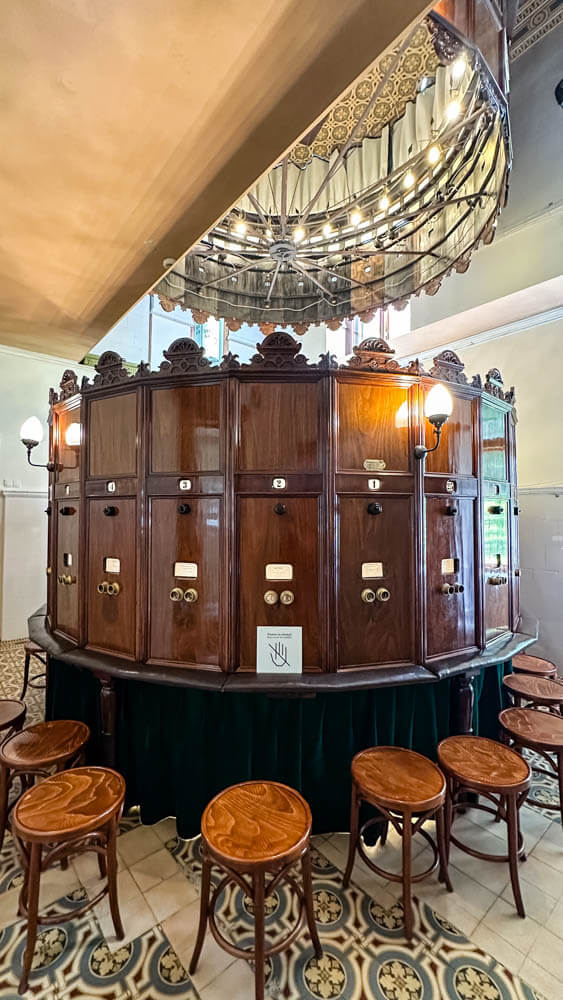
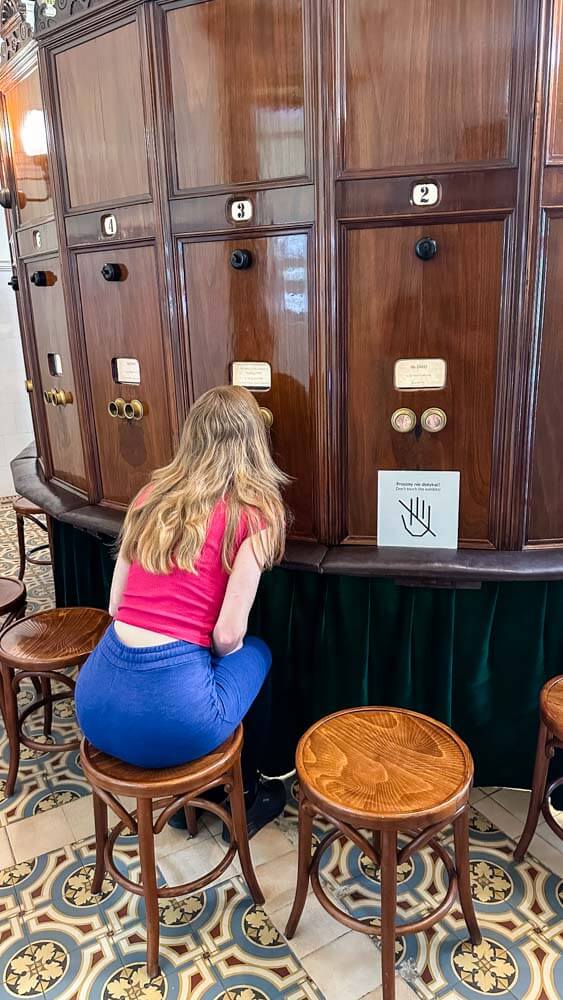
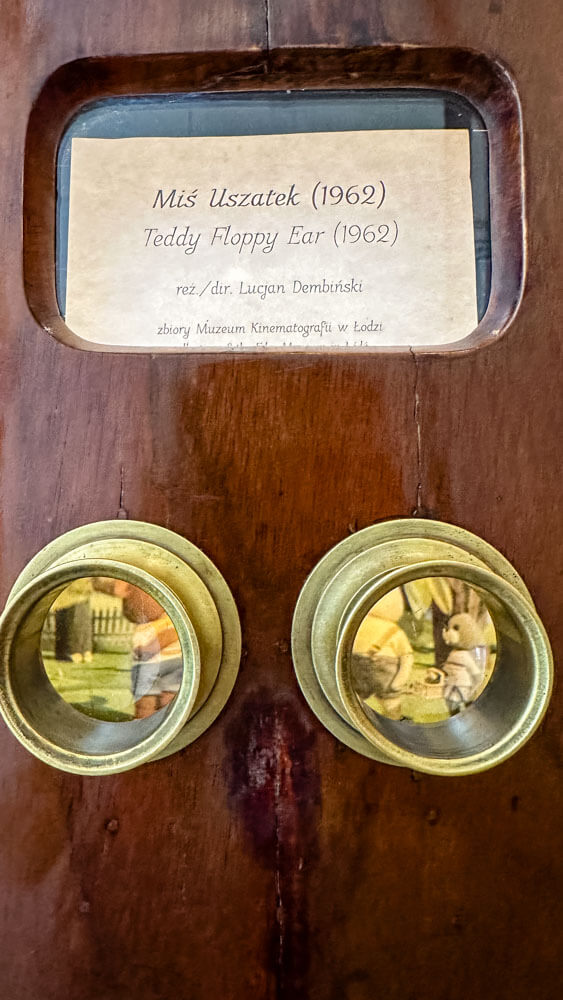
We visited on a weekday and shared the palace with a crowd of school kids who similarly loved this palace and museum in one. Needless to say, the interactive exhibits of the early filmmaking devices were their favorite.
As an adult, you’ll pay PLN 28 to visit Scheibler’s Palace. You can check the museum’s website for the latest ticket prices and information.
Herbst Palace Museum
Przędzalniana 72
The Herbst Palace is another of Łódź’s architectural jewels that stands as a magnificent testament to the city’s rich industrial legacy and architectural grandeur.
It was constructed in the late 19th century for Matylda, the daughter of Karol Scheibler, and her husband, Edward Herbst. The couple played a significant role in the city’s textile industry, and their residence reflected their status and sophistication.
In 1976, the palace underwent significant restoration and was transformed into a museum where visitors can explore the lavishly decorated rooms and imagine what life of the rich may have been like in Lodz.
On the underground level, you can also check out an exhibition about the Herbst family that lived there.
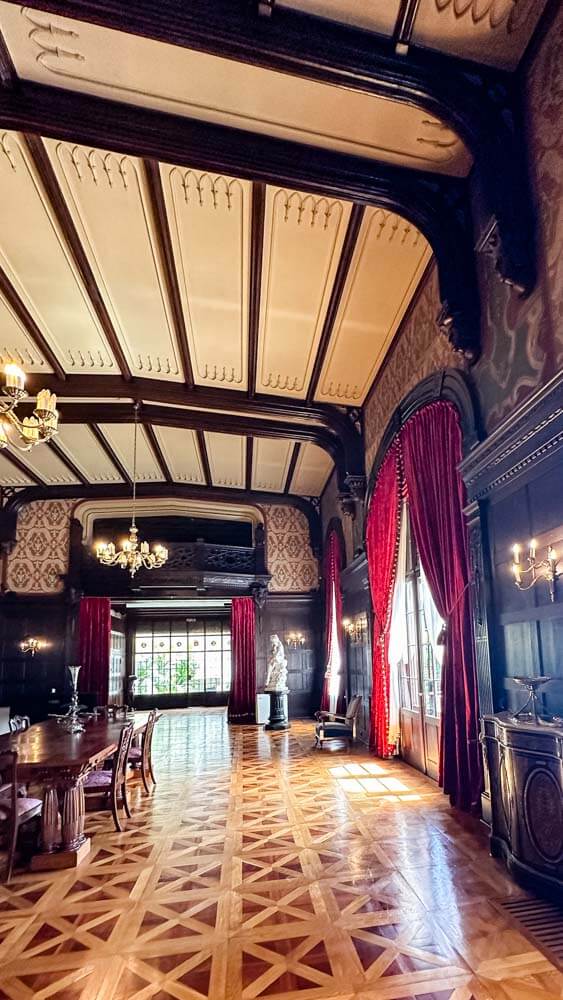
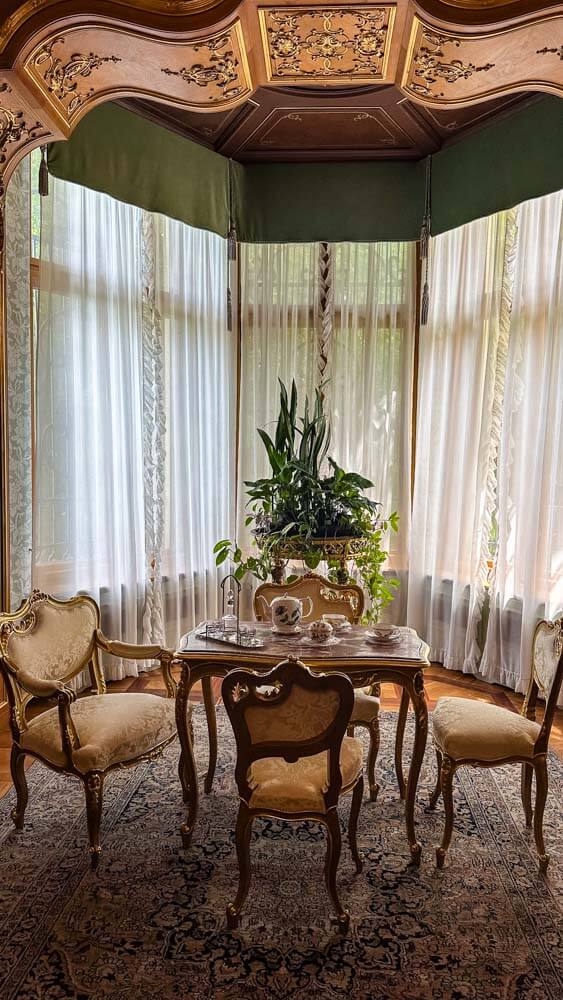
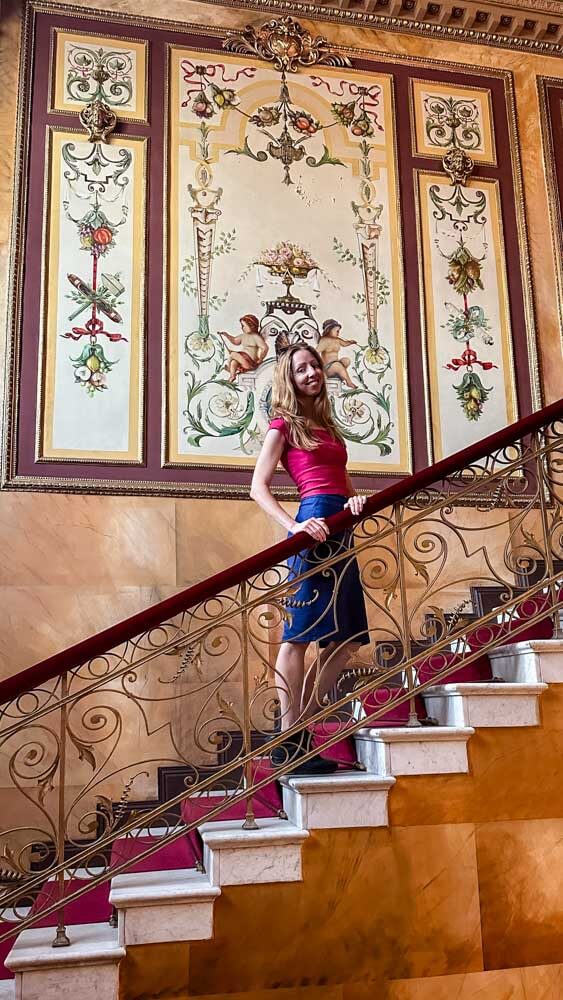
Don’t forget to stroll through the small but beautiful gardens, and, if you love modern art, pay a visit to the back building, which houses the Museum of Modern Art.
The entrance to Herbst Palace only costs PLN 20 for adults, while a visit to the Art Museum sets you back another PLN 15. You can find the latest ticket prices on the museum’s website.
Monopolis
dr. Stefana Kopcińskiego 62
Monopolis is the third largest industrial complex in Lodz after Manufaktura and Księży Młyn. Unlike the previous two, this one was state-owned and produced something completely different – vodka!
The Vodka Monopoly plant included all residential infrastructure so you can imagine that it was a vast complex. The production plant was the most modern in Poland in its era and by the 70s, it became an icon of the Polish spirit industry.
Its doors closed in 2017 and only 5 years later, a large revitalization project was started.
Nowadays, you can visit the area under the name Monopolis and easily spend a few hours dining, getting your coffee fix, as well as enjoy a cultural event or two. There’s even a gallery and a small museum of vodka production process (in Polish only).
The whole Monopolis is beautifully decorated with plenty of greenery and it has a pleasant vibe.
We visited Monopolis on the last day and I had to take many (!) photos with the iconic Lodz sign that Monopolis houses on the lower section. If you’ll feel similar about Lodz city, spread the love with a photo with the blue sign too!
Central Museum of Textiles
Piotrkowska 282
The Central Museum of Textiles is another vibrant testament to the city’s rich industrial heritage and evolution.
Housed in a 19th-century White Factory (Biała Fabryka), this museum offers a more immersive journey into the world of textiles, weaving together the threads of history, art, and industry.
Here visitors can explore the evolution of textile production techniques, marvel at intricate weaving patterns, and appreciate the artistry of various fabric designs.
Pay attention to the times when the century-old machines are turned on to show visitors how loud they used to be and to realize what the strenuous work operating them must have been.
The Central Museum of Textiles also features an impressive open-air section showcasing the architectural heritage of Łódź through a collection of preserved wooden buildings from the 19th and early 20th centuries, which were relocated to the museum grounds to preserve their historical significance.
Visitors are allowed to step back in time and explore the living history of Łódź’s wooden architecture. Each of the little buildings is an example of an actual house, which was often shared by more than one family. Their living conditions are explained and everything inside is left as if the inhabitants only stepped out to run an errand or two and would be coming back shortly.
Whether you’re a history buff, an architecture enthusiast, or simply curious about living conditions of the past, the open-air section adds a valuable and engaging dimension to your visit.
We liked all of the little houses and those most recent ones, from the 90’s, brought a wave of nostalgia to me, as I still remember such interiors from my childhood.
A regular ticket to all exhibitions within the Textile Museum costs PLN 39 – I highly recommend you get this one instead of picking individual exhibitions and paying for each separately. You can find an up-to-date price list on the museum’s website.
EC1 – the City of Culture
Targowa 1/3
The city of Łódź has been simply amazing at repurposing its industrial relics. In this case, they’ve converted their former heat and power station into the EC1 – the City of Culture. The sprawling EC1 complex features 5 centers:
- Science and Technology Center
- Center for Comics and Interactive Narrative
- National Centre for Film Culture
- Planetarium
- Street of the Elements
We visited the first three. In the Science and Technology Center, we strolled through several scientific exhibitions and got captivated by the measuring of distances in the space. We came across a passionate scientist who worked there and showed us many cool features including different stars and formations.
In this part of EC1, you can also climb or take an elevator to the top of a former cooling tower, now a nice viewpoint over Lodz. It’s 40 m (130 ft) tall.
The Center for Comics is devoted to the art and history of comics, graphic novels, and interactive storytelling. It houses a permanent collection of comic art, showcasing the history and evolution of the medium from its early beginnings to contemporary works.
It’s a fun place and one where you can even try out many of the techniques of comic creation, as well as play games. At the time of our visit on Saturday, we were almost alone there! So we could play and test every interactive exhibit.
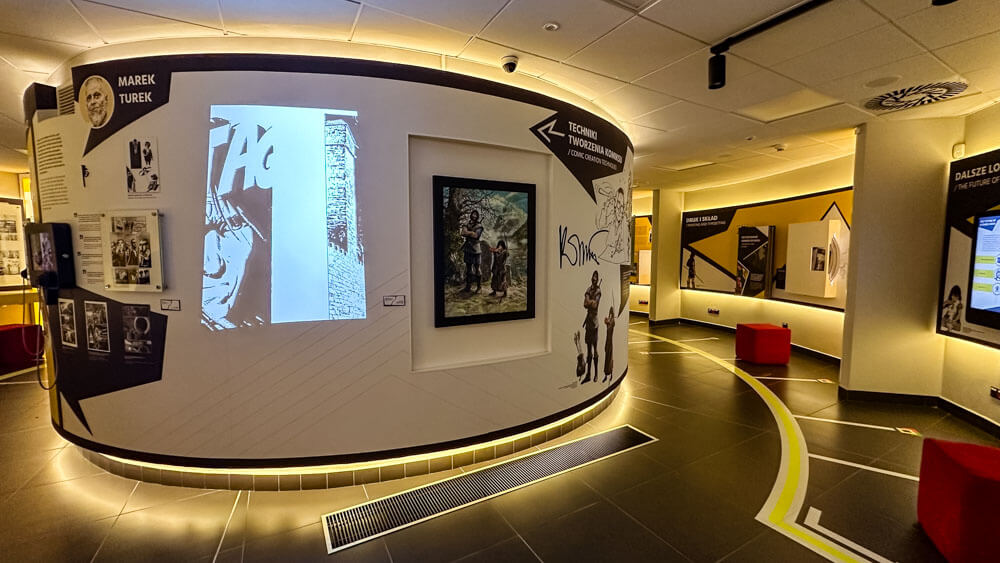
In case your caffeine levels dip dangerously during a visit to the EC1, head to a nice café with additional outdoor seating that is located on the ground floor of the Comic Center.
Ultimately, the Film Center features exhibits on the history of Polish cinema in an exhibition called Polonia Cinema. You know, Lodz has played a significant role in shaping the landscape of Polish and international cinema, producing some of the most influential filmmakers, actors, and cinematographers in the industry. The famous Łódź Film School had e.g. Roman Polanski as a student. Additionally, David Lynch is known to have a special affinity for the city of Łódź and its prestigious film school.
You can check out the exhibition on your own or get an audio guide to fully immerse yourself into the world of Polish cinema.
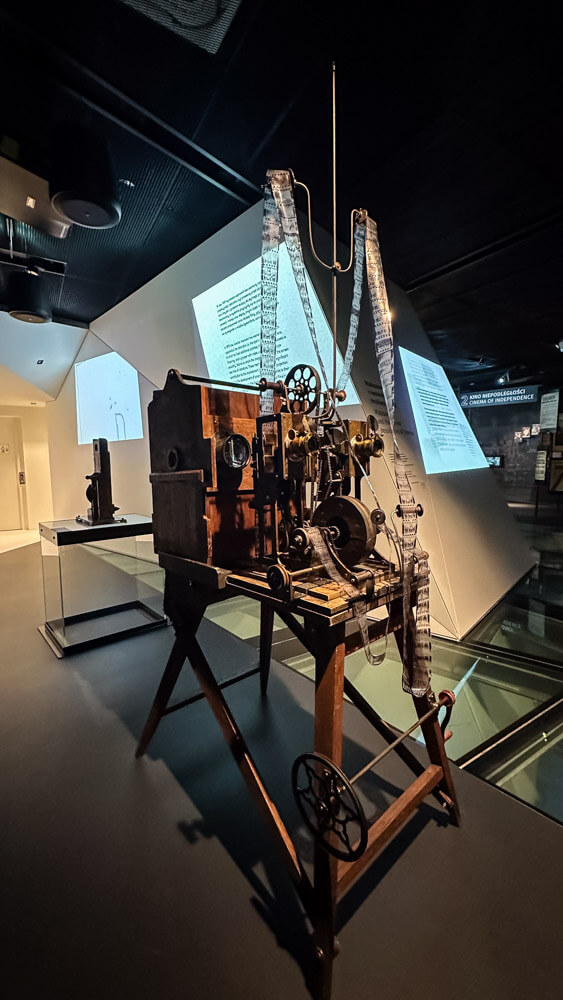
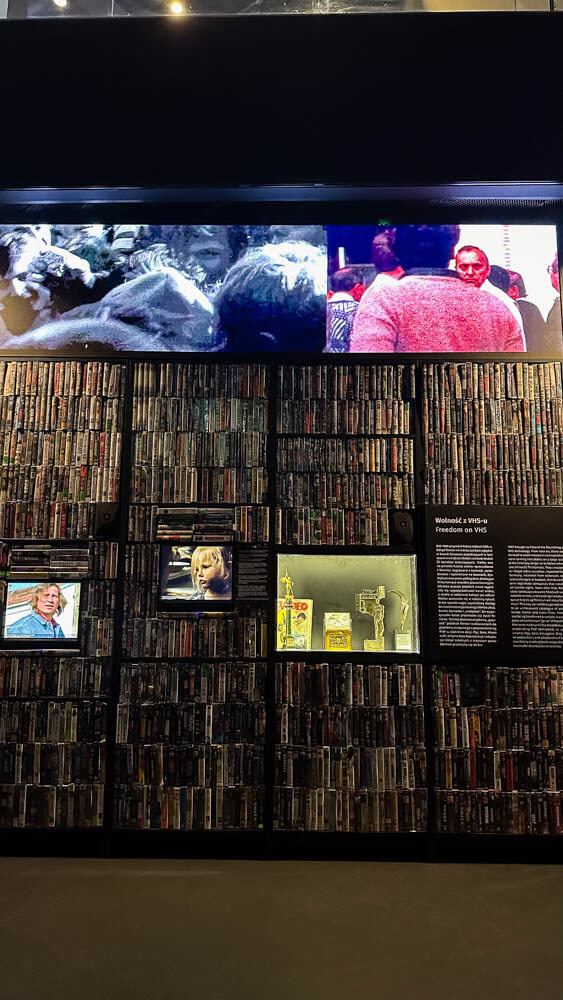
When visiting the EC1, be aware that it’s spread between two main sections, which are standalone buildings – East and West.
A standard ticket costs PLN 27. You can check the EC1 website for the most up-to-date ticket prices.
Łódź Zoo (Orientarium)
Konstantynowska 8/10
The Łódź Zoo is another must see if you have time in your schedule, especially if you’re traveling with children.
Home to over 2,200 animals, representing nearly 450 species, it boasts an impressive variety of creatures from around the world. Among the animals there are also elephants, which can be observed while bathing!
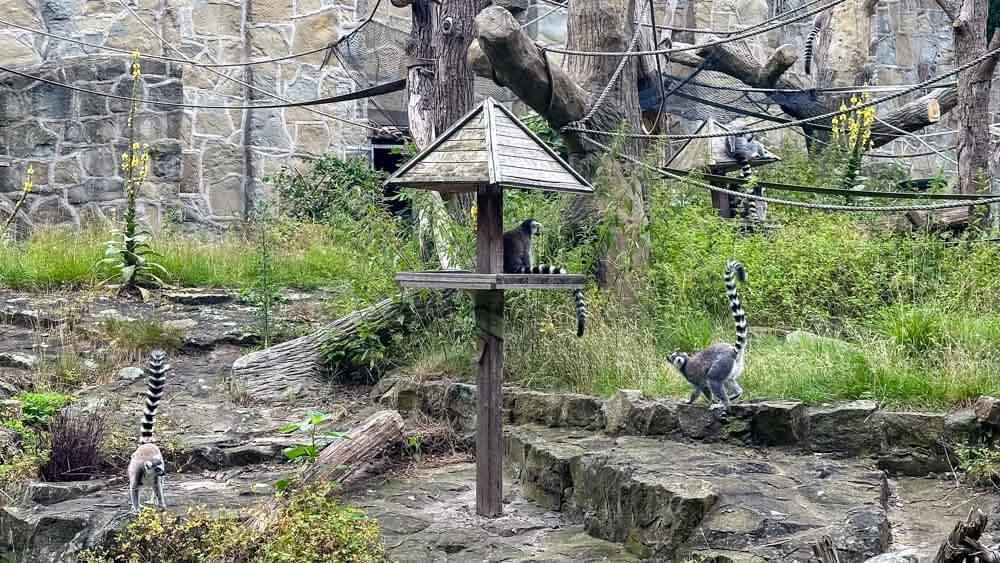
The zoo is divided into several thematic zones, each offering a unique glimpse into different habitats and ecosystems such as the African Savannah (with giraffes, zebras, antelopes, and more), the Asian Jungle (including tigers, red pandas, and various primates), the Reptile House (showcasing snakes, lizards, and amphibians from across the globe), and a Bird Aviary (including parrots, flamingos, and eagles).
The main highlight, though, is a massive Aquarium containing sharks, stingrays, and over 180 other species distributed among 10 oceanic reservoirs containing 3 million liters of water.
The main aquarium features a 27 meter long underwater tunnel making it the longest in Europe! The aquarium zone was my personal favorite. It’s just so cool when you have the sea life surrounding you.
Don’t be like us and don’t try to manage a visit to the Zoo in an hour and a half. Allowing at least half a day for your entire zoo exploration is advisable.
A regular ticket to the zoo costs PLN 80. There are many different options, including group tickets. You can check Lodz Zoo’s website for details.
Radegast Station
aleja Pamięci Ofiar Litzmannstadt Getto 12
The Radegast train station is a sobering reminder of one of history’s darkest periods. This former railway station, now a memorial, commemorates the tragic events of the Holocaust and the lives lost during World War II.
Since Lodz had the second largest ghetto after Warsaw, a transport station was constructed on the outskirts.
Between 1941 and 1944, it was the departure point for thousands of Jews, Roma, and other persecuted groups who were forcibly deported to death camps such as Auschwitz, Chelmno, and Treblinka.
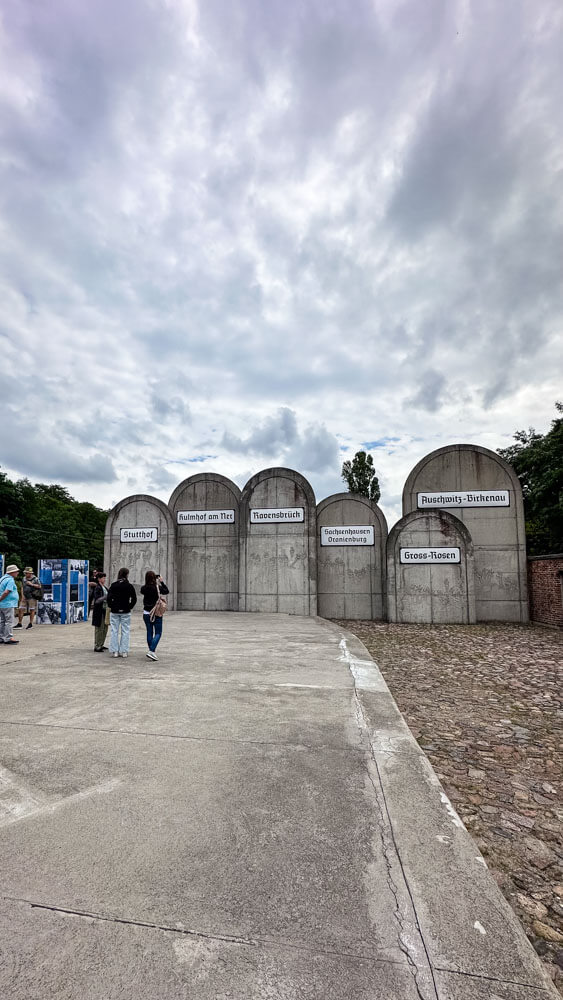
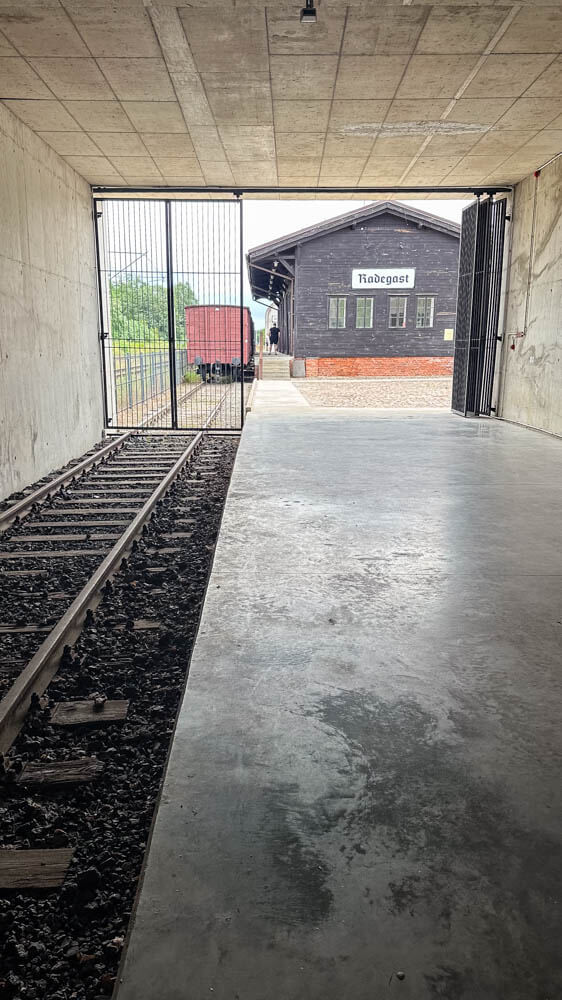
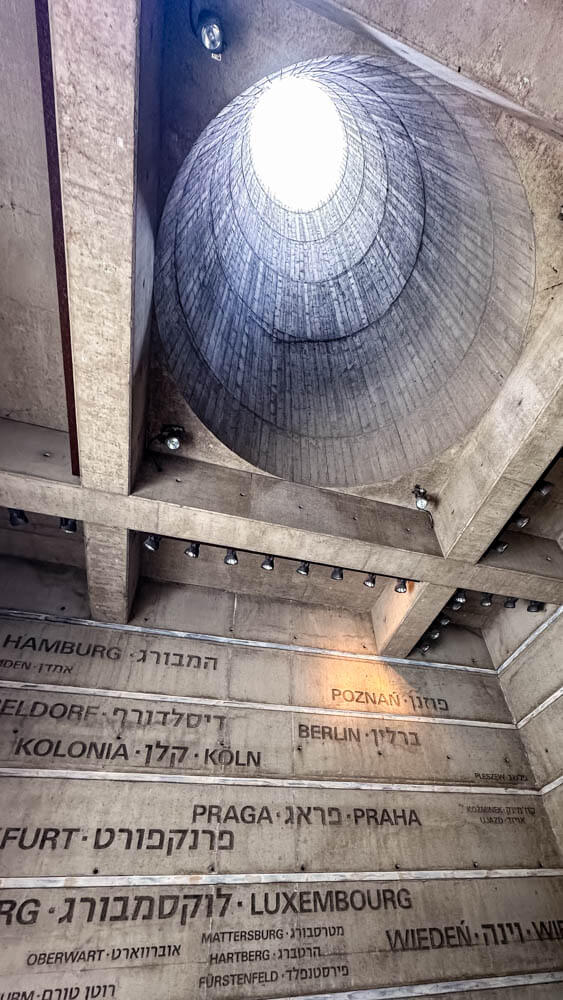
The Radegast Station memorial fosters a deeper understanding of the events and encourages reflection on the consequences of hatred and intolerance.
Albeit small in size, there’s a lot to see in the Radegast station including a little museum with a map of Lodz, a set of train wagons, and a long tunnel with lists of names.
While you’re free to roam the outdoor part of the monument, to visit the one-room-exhibition with a historical map of Lodz costs PLN 12. You can check the monument’s website for the most up-to-date information and ticket prices (available in Polish).
Jewish Cemetery
Bracka 40 (entrance from Zmienna Street)
We were curious to check out the Jewish Cemetery especially to visit the tomb of the great industrialist magnate Izrael Poznanski. And our expectations were fully satisfied. His and his family members’ tombs are located in a large futuristic mausoleum that looks like it may have landed here from space.
Otherwise the Jewish cemetery is a peaceful spot set in nature and you could spend hours there meditating and feeling the calm.
To visit, you need to pay PLN 20 for adults. You can find more information about the cemetery on its website.
Where to Stay in Lodz
I highly suggest you stay on Piotrkowska Street. It’s simply the most convenient – you’re near all the action and it’s easy to get anywhere from there.
Hotel Pietryna
Piotrkowska 40
We stayed at the wonderful Hotel Pietryna, which I could hardly praise enough. Its name refers to the nickname of Piotrkowska Street.
The boutique, 4-star hotel gives a high-class experience. Imagine comfortable rooms, interior decor that’s both tasteful and slightly tongue-in-cheek, and an amazing restaurant. I absolutely loved our breakfasts there and wish time would slow in the mornings! The ambiance is just beyond lovely and features even a glass wall, inviting daylight in beautifully.
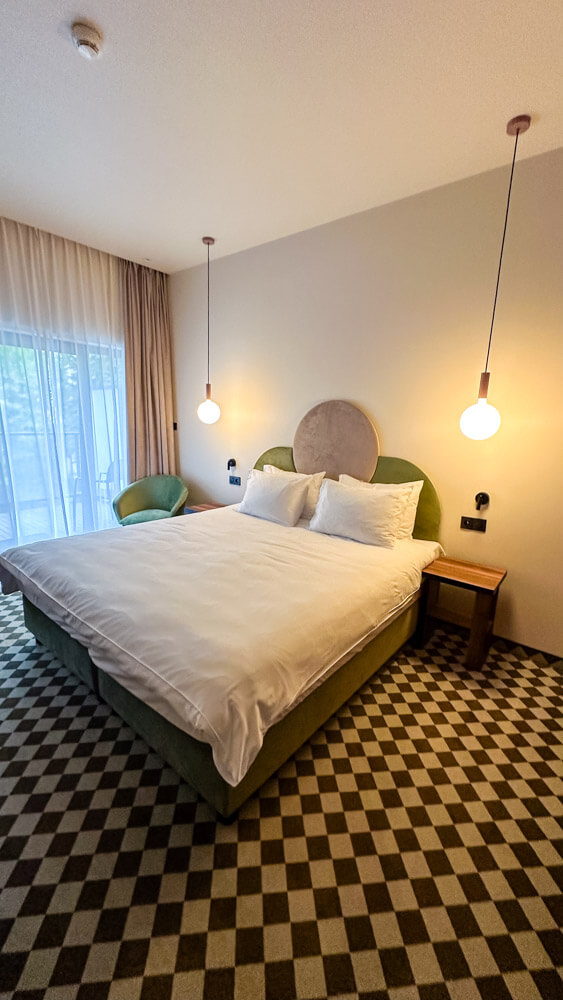
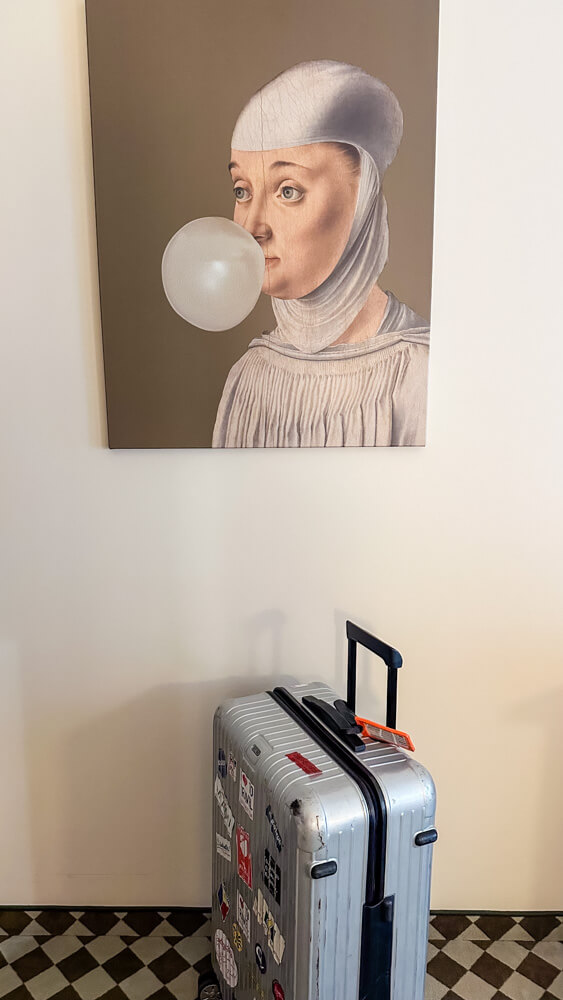
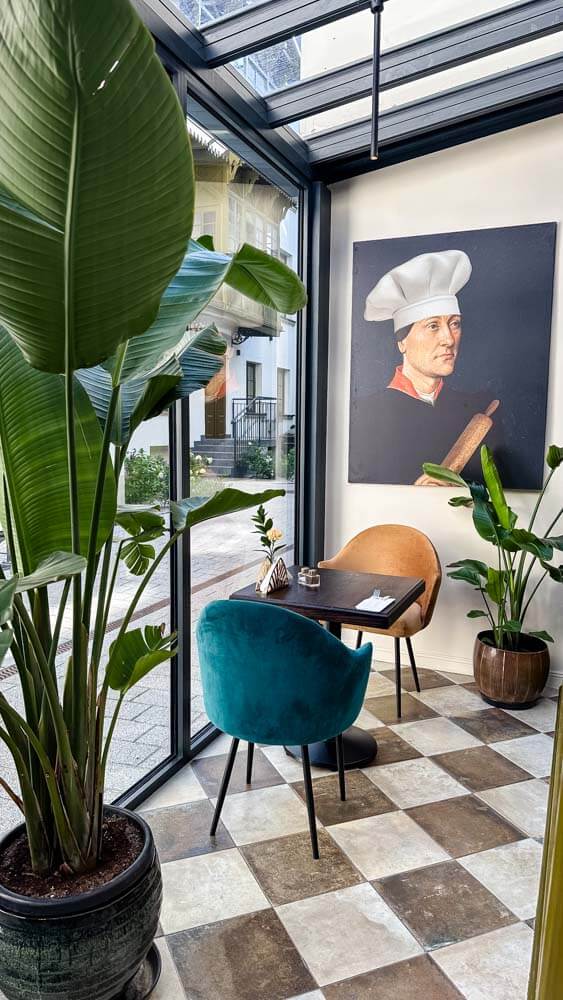
Hotel Pietryna is family-friendly, too. We saw all kinds of people, from businessmen to families with cheeky kids.
Where to Eat in Łódź: Restaurants
There are so many great restaurants in Łódź Poland that it’s literally impossible to list them all. We had some truly exceptional culinary experiences during our visit and can solidly recommend a few options for you.
Pierogarnia Stary Młyn
Piotrkowska 37
No trip to Poland would be complete without eating pierogi and the Pierogarnia Stary Młyn (Old Mill) is the best place to indulge in this beloved national dish.
Located right on Piotrkowska Street, they have a charming wooden decor as well as a large summer garden so you can enjoy your classic Polish meal along with the entertainment of the hustle and bustle of the city’s most vibrant street around you.
We went for some meaty dumplings (pork & duck) and were beyond satisfied. I loved how you can specify the size of your meal by choosing a serving of either 5 or 9 pierogi.
Wooden, playful, and fun – that’s the interior of Pierogarnia “Old Windmill”. The sign on the photo translates: What does a dumpling have to do with a windmill? :)
Bawełna (Cotton) at Manufaktura
Ogrodowa 46 19A
We went to Bawełna restaurant with our guide Justyna just before exploring the Manufaktura complex, which Bawelna forms a part of. The red brick walls, historic flooring and overall interior perfectly retains the feel of its industrial history and transports you to Łódź’s illustrious past.
On top of that, the menu is excellent. They specialize in Italian and Mediterranean cuisine including delicious steaks, seafood, pizza, and pasta dishes, with a large selection that is prepared to please even the most finicky eater.
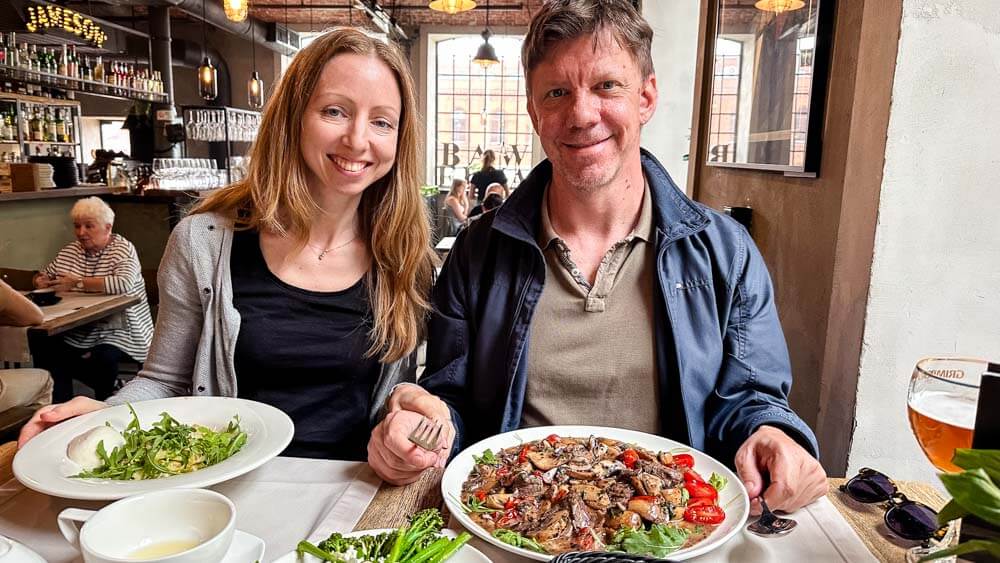
We enjoyed a truffle-flavored beef with a side of baby broccoli and a pistachio pasta. The portions were so big we could hardly breathe! But when a meal is this good, you have to finish it no matter what, right?
Imber
Piotrkowska 43
Imber is a unique Jewish restaurant offering a wide range of delicious gastronomy. It’s conveniently located in a cozy courtyard just off Piotrkowska Street.
I’m so glad we got recommended Imber because it’s a place that we would have otherwise overlooked and that would be a shame. The fusion of traditional Jewish meals with a modern twist offered flavors that transported us out of Europe in the most delicious way possible.
We tried żulik (Turkish bread) with pastrami, baked eggplant, and labneh, which included baked cherry tomatoes and za’atar. To top it off, a parfait with halva ‘wool’. Yum!
Btw. if the weather allows, choose a table outside, it’s a lot nicer!
Fatamorgana at Księży Młyn
Księży Młyn 16
Plan your visit of Księży Młyn around lunch time because eating at Fatamorgana is a treat. The modern bistro has lunch menus and a small menu of staples like burgers, many with a local twist. We tried the local soup called zalewajka made with rye flour starter, potatoes and veggies.
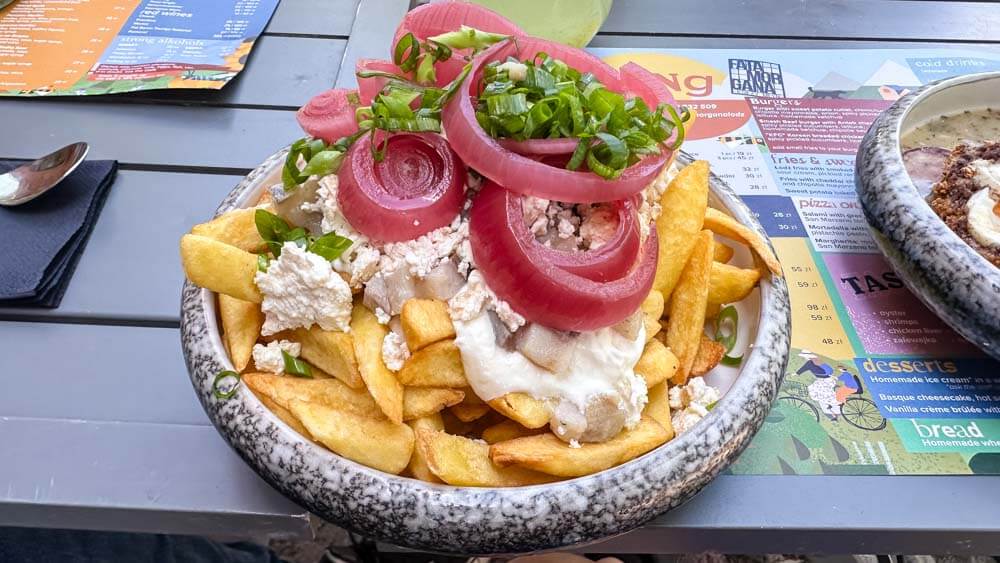
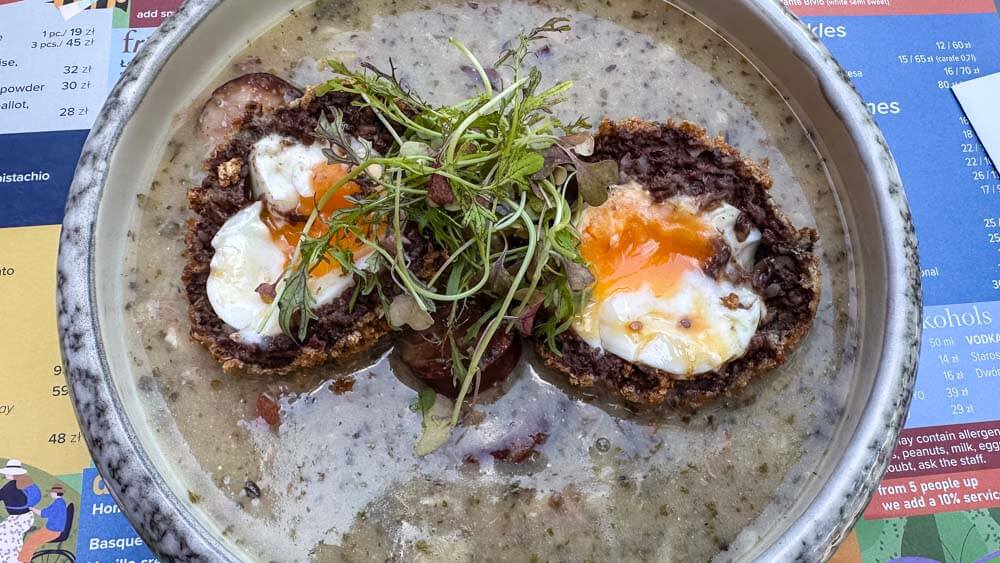
Also, since herring is eaten a lot in this part of Poland, we ordered fries with herring and that was pretty unique! My husband also needed some comfort food and the burger he got was delicious.
La Mia Fabbrica at Monopolis
dr. Stefana Kopcińskiego 60A
We chose to eat at La Mia Fabbrica when exploring the Monopolis complex. This Italian restaurant serves pizza and Italian staples.
We tried their aglio e olio and I also ordered a duck confit with gnocchi. Once I saw a chocolate fondant with pistachio ice cream on the menu, I couldn’t resist. All perfectly yummy!
Ato Ramen
Franklina Delano Roosevelta 6
My husband and I are huge ramen fans so when our Lodz guide Justyna recommended it, we ran there even though we were only mildly hungry!
Ato Ramen doesn’t take reservations and there’s usually a line of people waiting to get in. We got lucky on a Saturday evening and waited only about 5 minutes. We got a seat at the bar, which provided a full view of the kitchen area. And what a performance it was, to watch the team of professionals creating rich bowls of deliciousness.
Ato Ramen offers all the classics, as well as a few other unique recipes (try the pistachio!), so it’s got something for everyone, and I could not give a higher recommendation to all hungry ramen fans.
It may have been the best ramen I’ve ever had! And no, I haven’t been to Japan yet. :)
Cafés in Łódź
Łódź boasts a plethora of unique and cozy cafés, each with its own distinct character. From trendy modern establishments to quaint, historical coffee houses, there is something to suit every taste. Some of my personal faves that I can highly recommend are:
Piotrkowska & around
The Brick Coffee Factory (both locations on Piotrkowska), Owoce i Warzywa, and The White Bear Coffee, which is also a very popular ice cream shop, making it an excellent choice for a hot summer day.
Near Lodz’s Unicorn, you can find Etno Café. While this one was not on our list of specialty cafés to check out (it seems pretty new), we loved its vibe and big windows overlooking a part of Piotrkowska, which is adorned with the Unicorn Stables and serves as a transportation hub. It’s great for people-watching, and the coffee was top-notch too!
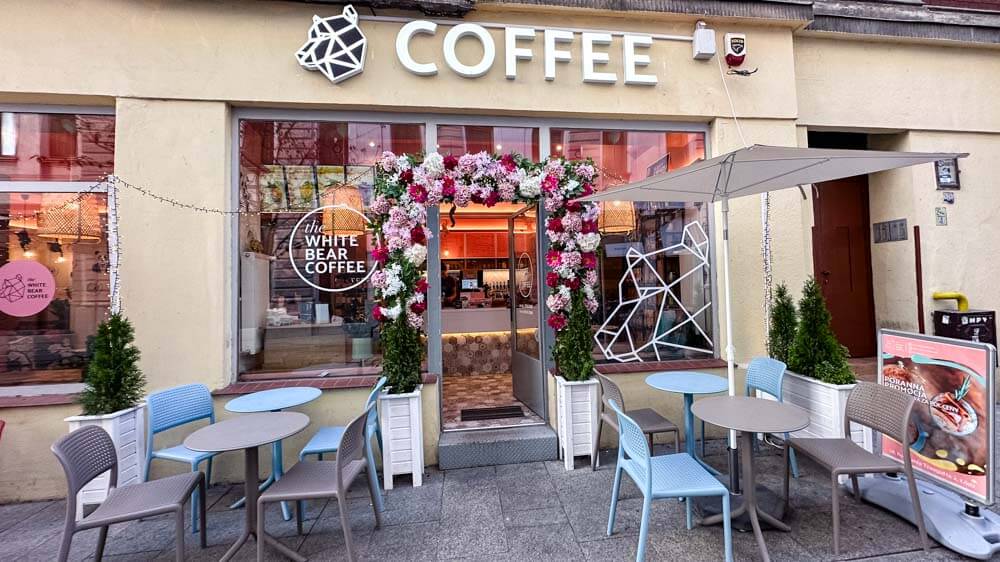
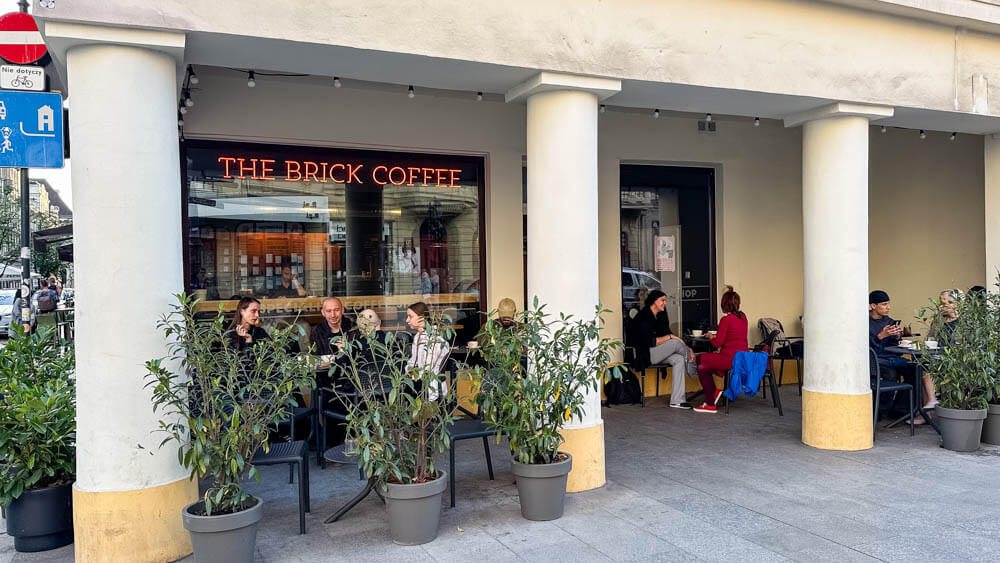
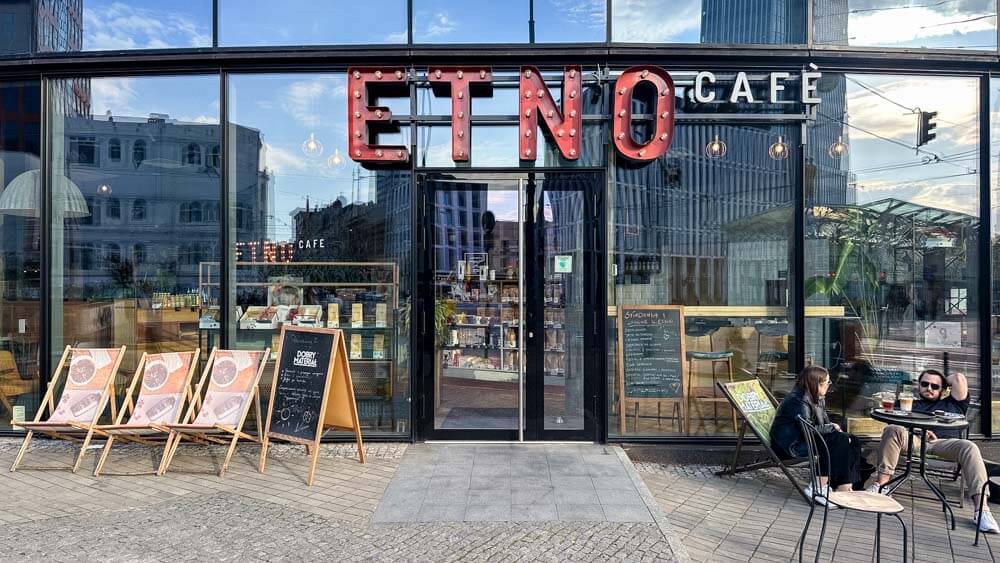
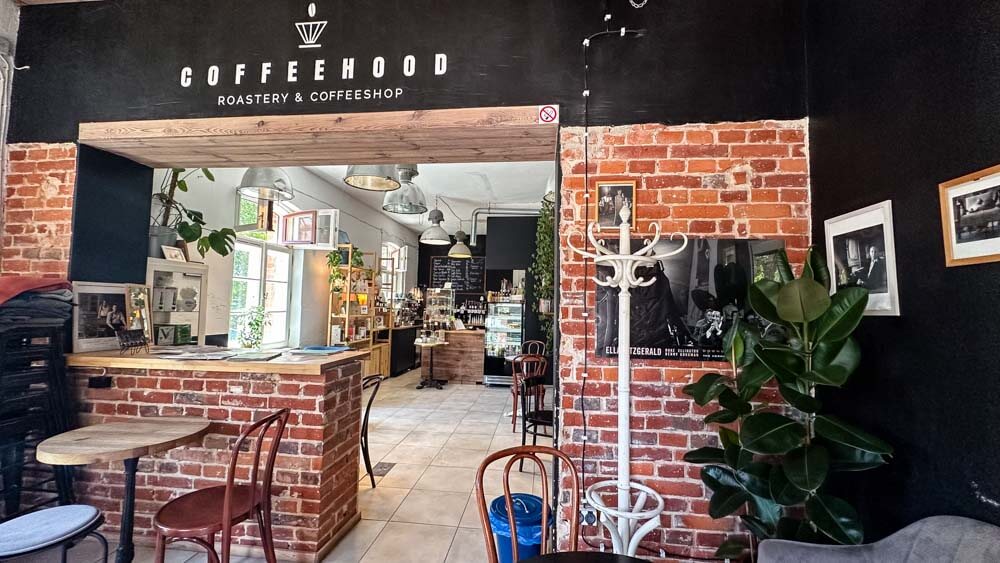
Księży Młyn
Of course Księży Młyn complex even has a café. We encountered the nice little Coffeehood, which turned out to be an ideal place to take a break from exploring.
For a larger selection of specialty cafés, I recommend checking out the Lodz page of European Coffee Trip, also available as an app.
Getting to Łódź
Lodz has a small airport called Władysław Reymont Lodz Airport with direct flight connections to/from Dublin, London, Bergamo, Brussels, and Alicante. These flights are operated by Ryanair and Wizzair. Buses 65A and 65B can then take you to the city center.
However, you can always fly into any other city in Poland and use a train. Direct trains connect Lodz with Warsaw, Kraków, Wrocław and Gdańsk.
There are 3 main train stations in Lodz, with Łódź Fabryczna being the most central one. The other two are Łódź Kaliska and Łódź Widzew stations.
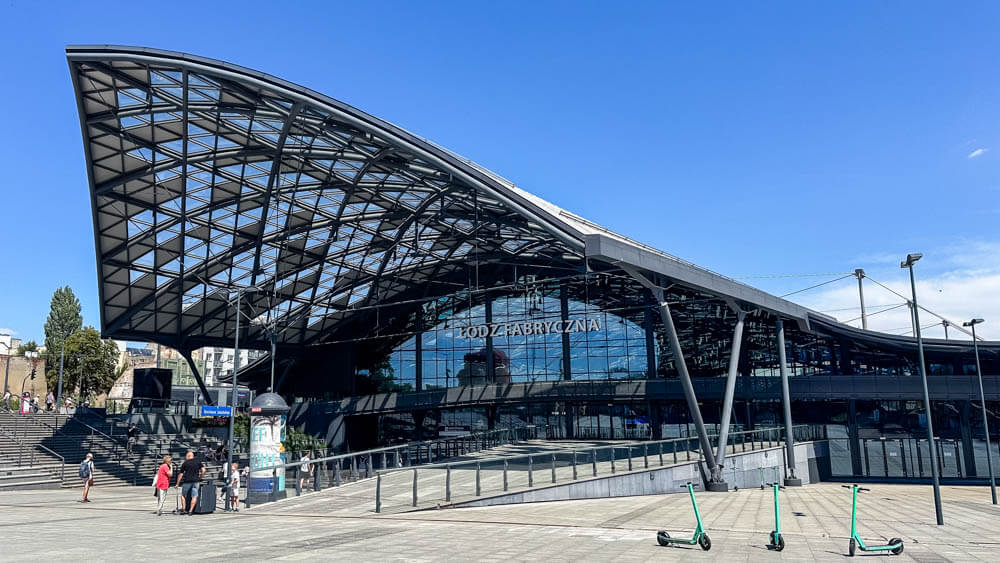
Getting Around Łódź
While it’s easy to walk almost anywhere if you’re based on PIotrkowska, for further-away destinations, such as the Zoo or the Jewish Cemetery and Radegast station, there are trams and buses. We used Google Maps to plan our journeys and it worked pretty well.
When short on time, we also used Bolt with no issues.
There are shared bicycles too. We didn’t use them but it should be easy to do so. Check out the Lodz Tourism Board’s info on navigating Lodz.
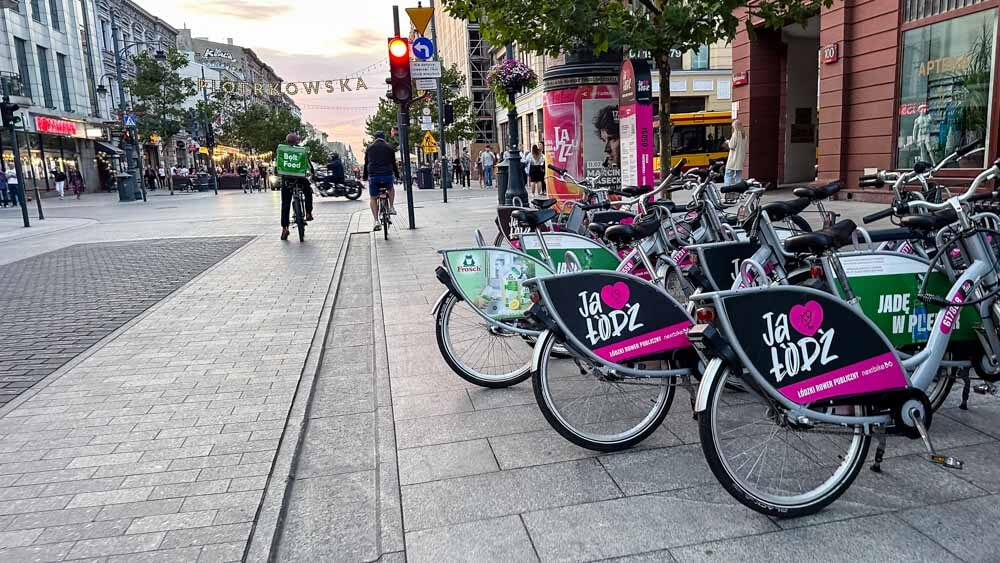
Map of All the Places Mentioned
For a better overview, I’ve created a map of all the Lodz tourist attractions mentioned above. The one below is just an image but feel free to click through to an interactive version of the Google map.
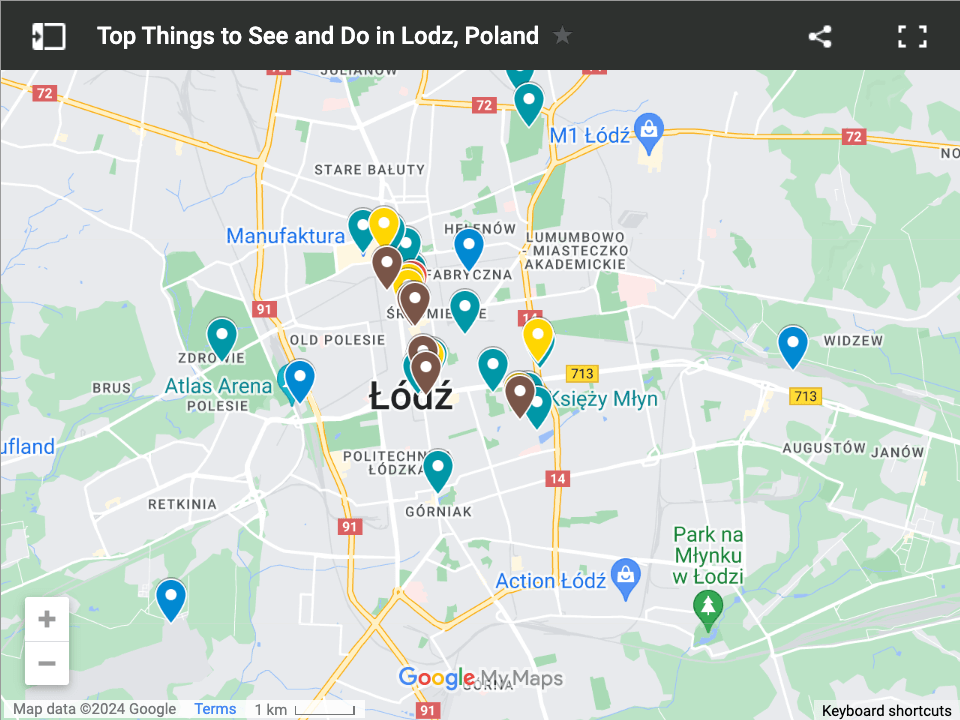
I hope I’ve answered your question, “is Łódź worth visiting?” so that you have no further doubts, and you know exactly what to do in Łódź.
As you can see there are so many things to do in Łódź, making sightseeing Łódź Poland a great idea for any time of the year. I highly recommend staying 3-4 days like we did in order to experience the city fully.
Otherwise, you should be fully educated about what to see in Łódź now so you can pick and choose from the best destinations in Łódź city as you go.
Let me know in the comments below if you’ve been to Lodz already and what you think! If you haven’t visited yet, are you intrigued now? Do let me know your thoughts!
Veronika of Travel Geekery was able to explore Łódź thanks to a collaboration with the Łódź Tourism Board. All opinions are her own and unbiased.


